The Samsung QN70F is quite a decent mid-range television. Its strongest feature is definitely the smoothness of the image – thanks to the 144 Hz panel, low input lag, and a wealth of gamer features, we have here a recipe for nearly the perfect gaming display. It will also perform well for sports fans – the picture is fast, clear, and nothing tears. When it comes to picture quality – it's really not bad. The VA panel offers good black levels, brightness is better than average, and colors look great after calibration. Samsung advertises the QN70F as Neo QLED, meaning Mini LED, and in a certain sense, one can view it that way – but only partially. The backlighting is edge-lit, so it falls short of true Mini LEDs with local dimming. It's a shame because marketing does its job, and the user might feel a bit misled. Additionally, there are some small shortcomings – no USB recording, no DTS support. But despite everything, the QN70F makes a really good impression. It may not be a "true" Mini LED, but for its price, it's a solid piece of television – especially for gamers and anyone who enjoys fast, dynamic content.
- Matching (Score)
- Our verdict
- TV appearance
- Where to buy
- Contrast and black detail
- HDR effect quality
- Factory color reproduction
- Color reproduction after calibration
- Smoothness of tonal transitions
- Image scaling and smoothness of tonal transitions
- Blur and motion smoothness
- Console compatibility and gaming features
- Input lag
- Compatibility with PC
- Viewing angles
- TV efficiency during daytime
- Details about the matrix
- TV features
- Apps
- Playing files from USB
- Sound
Samsung Neo QLED QN70F / QN74F / QN77F vs Haier Q80FUX
Direct compare
Check the best price offer:
Samsung Neo QLED QN70F / QN74F / QN77FQN70F / QN74F / QN77F


Panel type: LCD VA
Resolution: 3840x2160
System: Tizen
Model year: 2025
Complete the survey to find out the result

Panel type: LCD VA
Resolution: 3840x2160
System: Google TV
Model year: 2025
Complete the survey to find out the result

Overall rating
7.1
5.8
Movies and series in UHD quality
6.7
5.9
Classic TV, YouTube
6.6
5.6
Sports broadcasts (TV and apps)
6.7
4.7
Gaming on console
8.5
6.7
TV as a computer monitor
8.2
6.0
Watching in bright light
6.3
4.8
Utility functions
7.2
5.6
Apps
8.7
9.6
Sound quality
6.4
5.5
Complete the survey to find out what fits your preferences
Advantages
Nice black and contrast
Above average panel brightness
High refresh rate of 144Hz
Many features for gamers: ALLM, VRR, Game Bar, etc.
Low input lag
4 HDMI 2.1 ports
Extensive and smooth Tizen operating system
Super slim design
Very good native contrast and decent black (thanks to the VA panel)
PFS / QLED Filter - Wide color gamut (about 95% DCI-P3)
Remarkably low input lag (below 10 ms at 120Hz and about 12 ms at 60Hz), making it a great choice for fast-paced games.
Support for 120Hz at lower resolution (Full HD) and the presence of VRR and ALLM
Support for Dolby Vision
Well-functioning file player from USB
Presence of analog headphone output (jack)
Disadvantages
No USB recording function
No DTS format
Issues with the HGIG function (for gamers)
Symbolic local dimming (Is this really MINI-LED?)
The image is quite "blown out" in HDR
Google TV software full of bugs, poor translations, and issues
Missing any image enhancement features (noise reduction, gradient smoothing)
Average brightness
Flat, bassless sound
High input lag in Dolby Vision mode for gaming
Weird and poorly ergonomic remote
Our verdict
The Haier Q80FUX TV is one of the most schizophrenic proposals we've had in our editorial office for a long time. On one hand, we have a solid piece of equipment: a VA panel that guarantees deep blacks, as expected in this segment, and a QLED quantum filter that can indeed generate juicy, eye-catching colors. This is the foundation on which a truly competitive mid-range receiver could have been built. Unfortunately, all this potential of the panel is systematically torpedoed by the software, which is a real ball and chain for this model. The biggest Achilles' heel of the Q80FUX is its total capitulation in the face of HDR10 content. The electronics seem to completely misunderstand how to interpret the signal, resulting in consistently blowing out the brightest parts of the image, turning them into a flat, milky blob. If we add the Google TV system, which – although functional – is unstable, full of errors, and irritating shortcomings, we get a picture of a raw product that clearly reveals the manufacturer's lack of experience. And just when we were ready to write this model off, we discovered its surprising niche. Once connected to a console, the Q80FUX undergoes a transformation. It turns out that this TV offers wonderfully low input lag, fully supports VRR, and can accept a 120Hz signal at Full HD resolution. In the gaming world, where responsiveness is everything, these parameters put it in a very good light. So we are dealing with a device of very narrow specialization. This is not a universal living room TV – it lacks stability and, above all, any correctness in handling films. It is more of a budget, large-format monitor for gamers who are able to consciously overlook all its software flaws in exchange for those few key attributes essential for console/PC at a relatively affordable price.
TV appearance
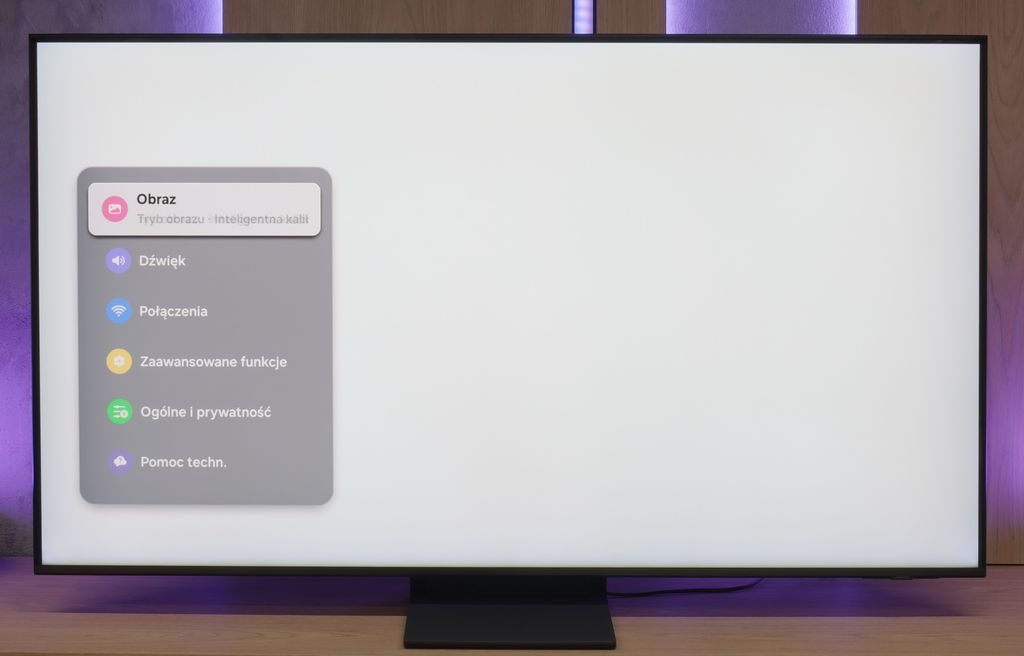
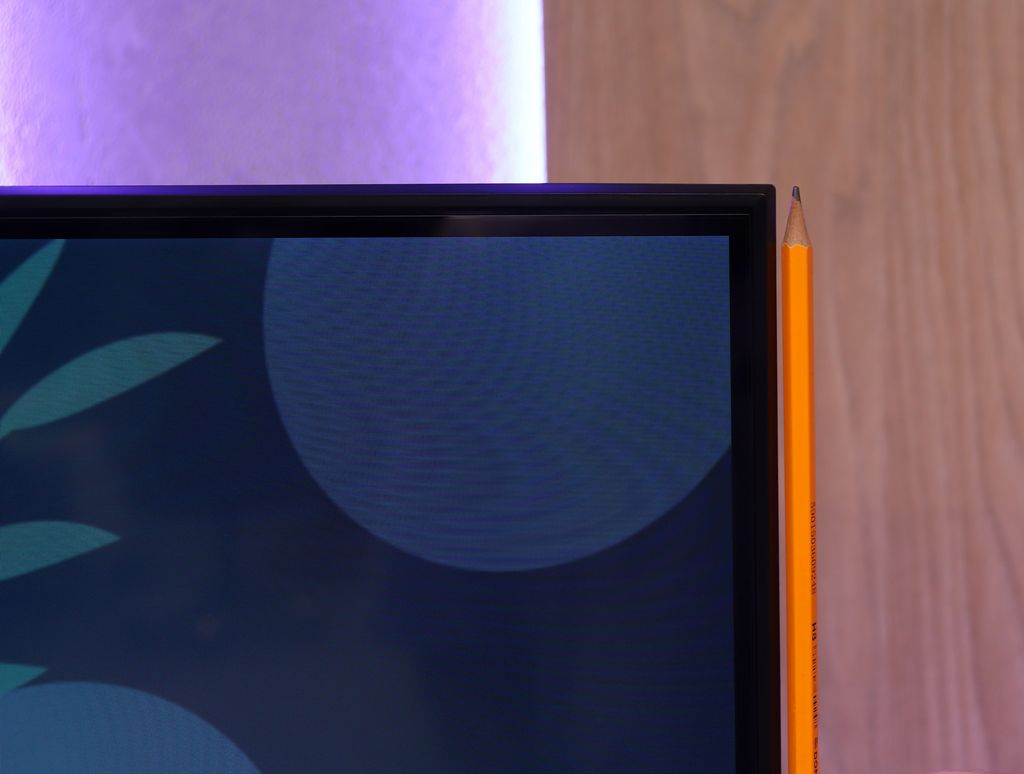
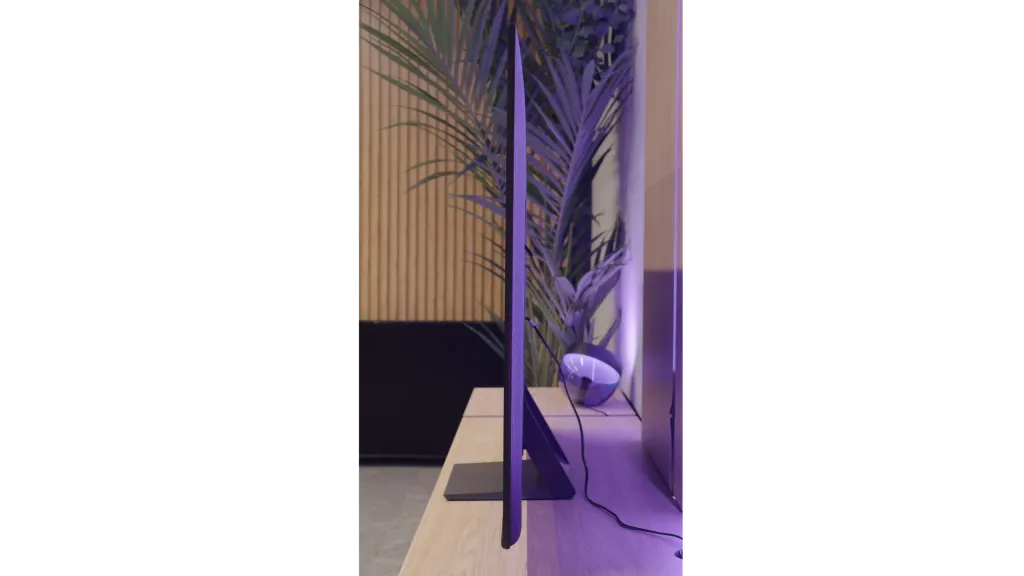

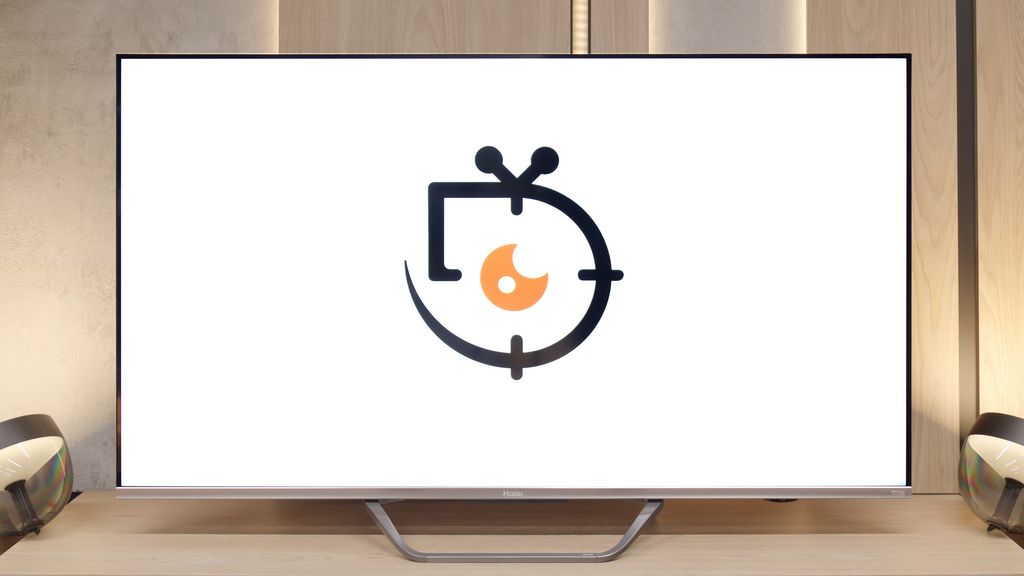
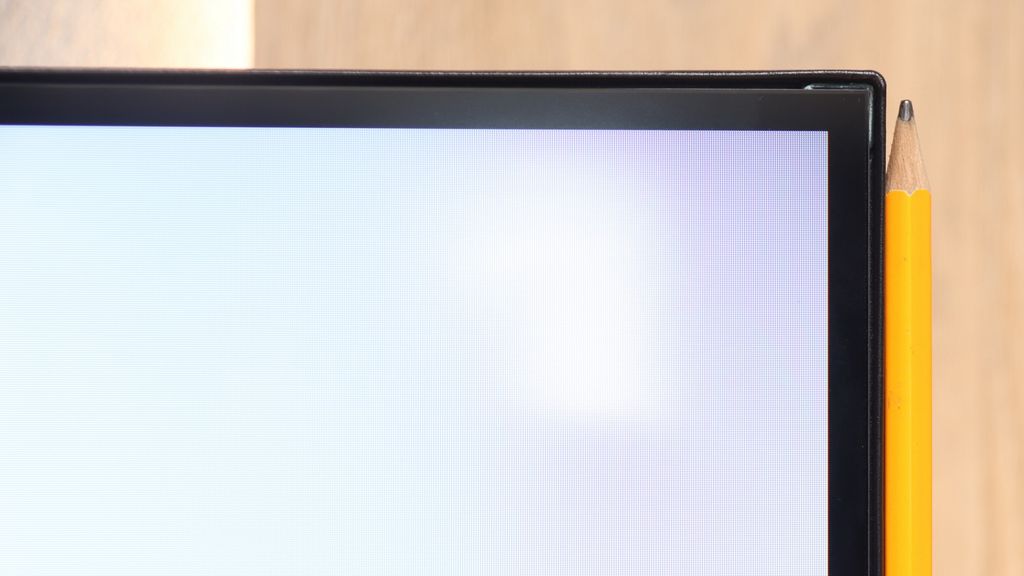
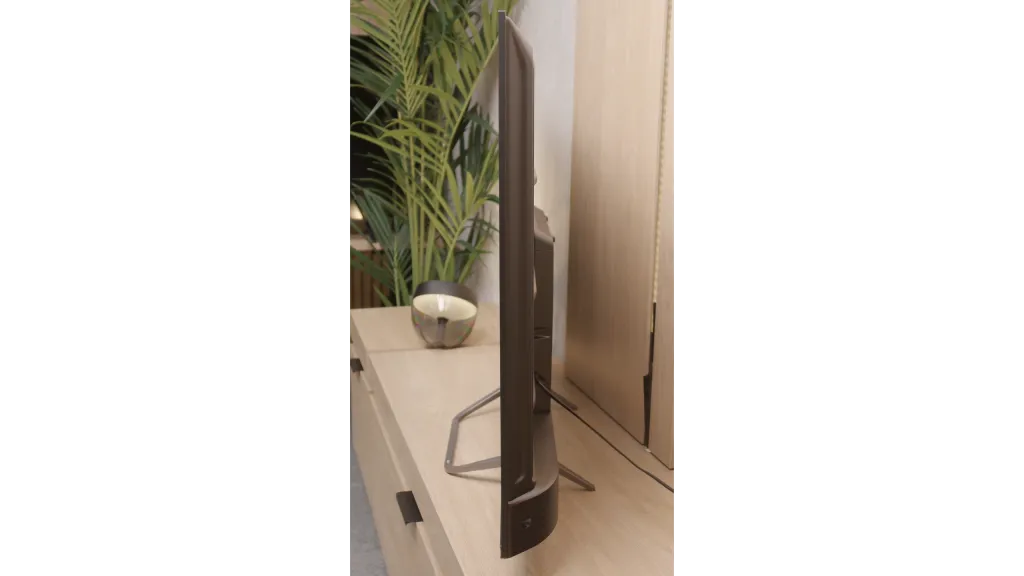
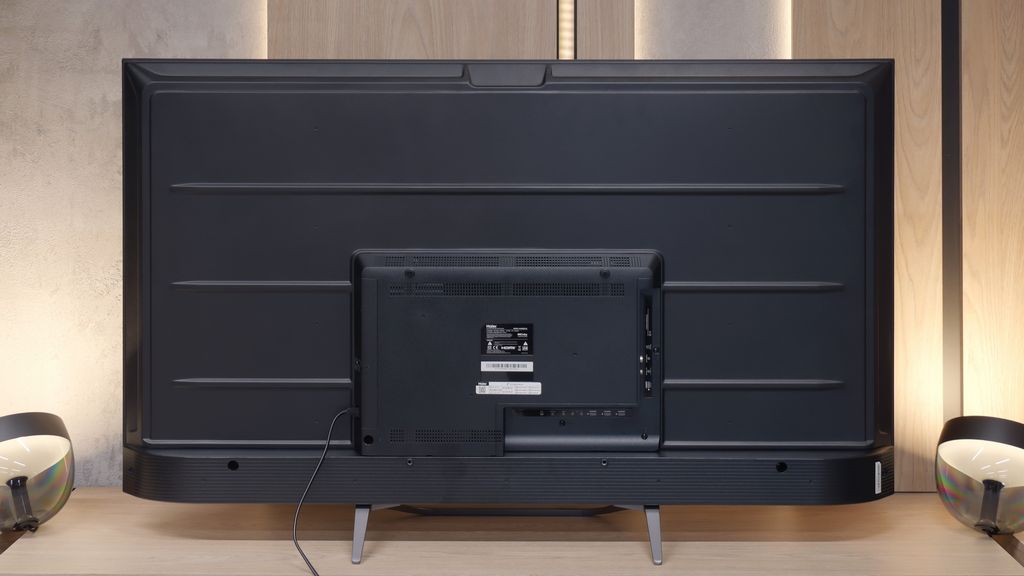
Contrast and black detail
6.2/10
6.3/10
Local dimming function: Yes, number of zones: 20 (1 x 20)
Local dimming function: No
Contrast:

Result
9,200:1

Result
7,000:1

Result
5,350:1

Result
5,700:1

Result
5,300:1

Result
5,200:1

Result
7,400:1

Result
7,550:1

Result
7,300:1

Result
6,450:1
Halo effect and black detail visibility:
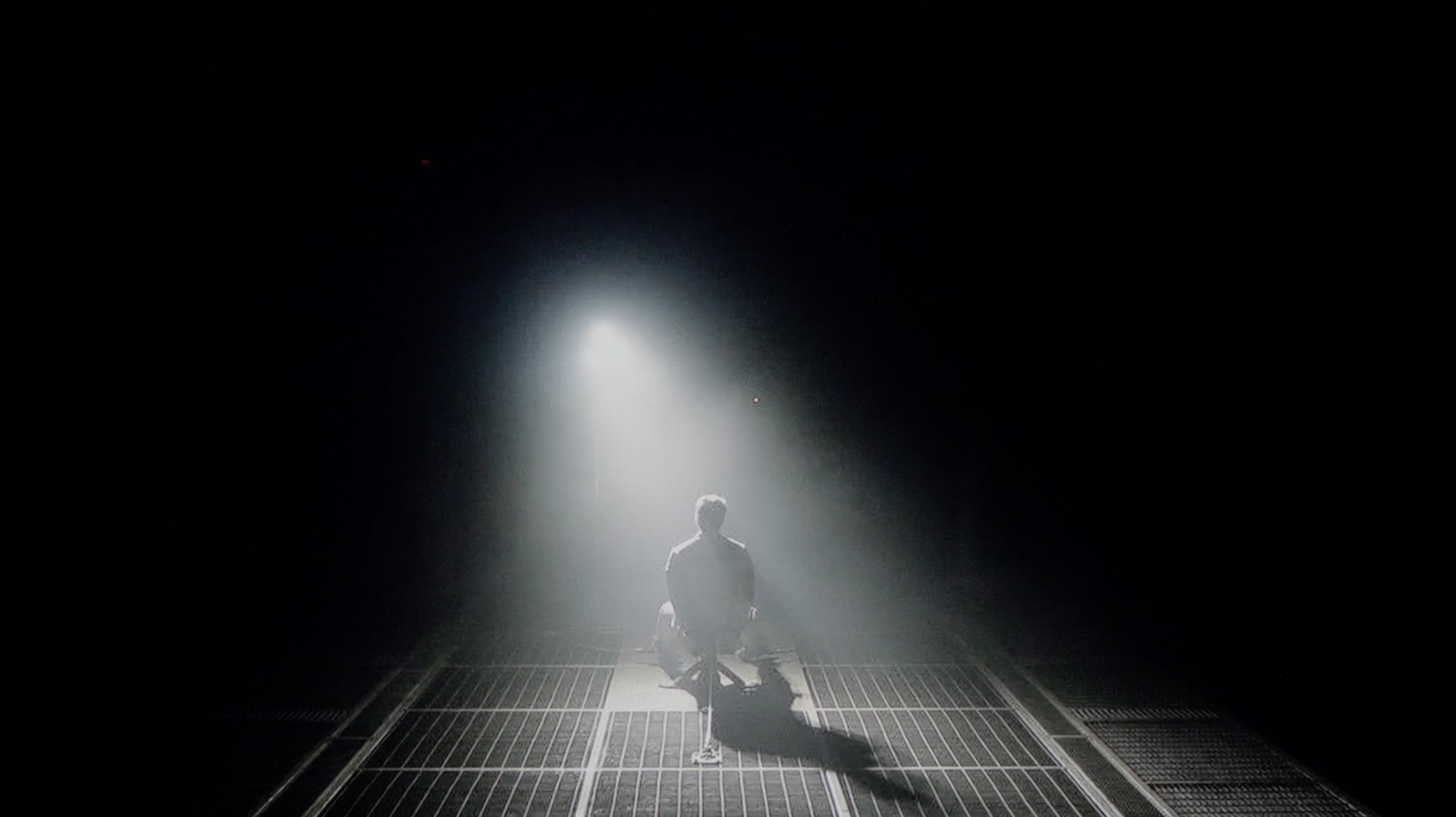
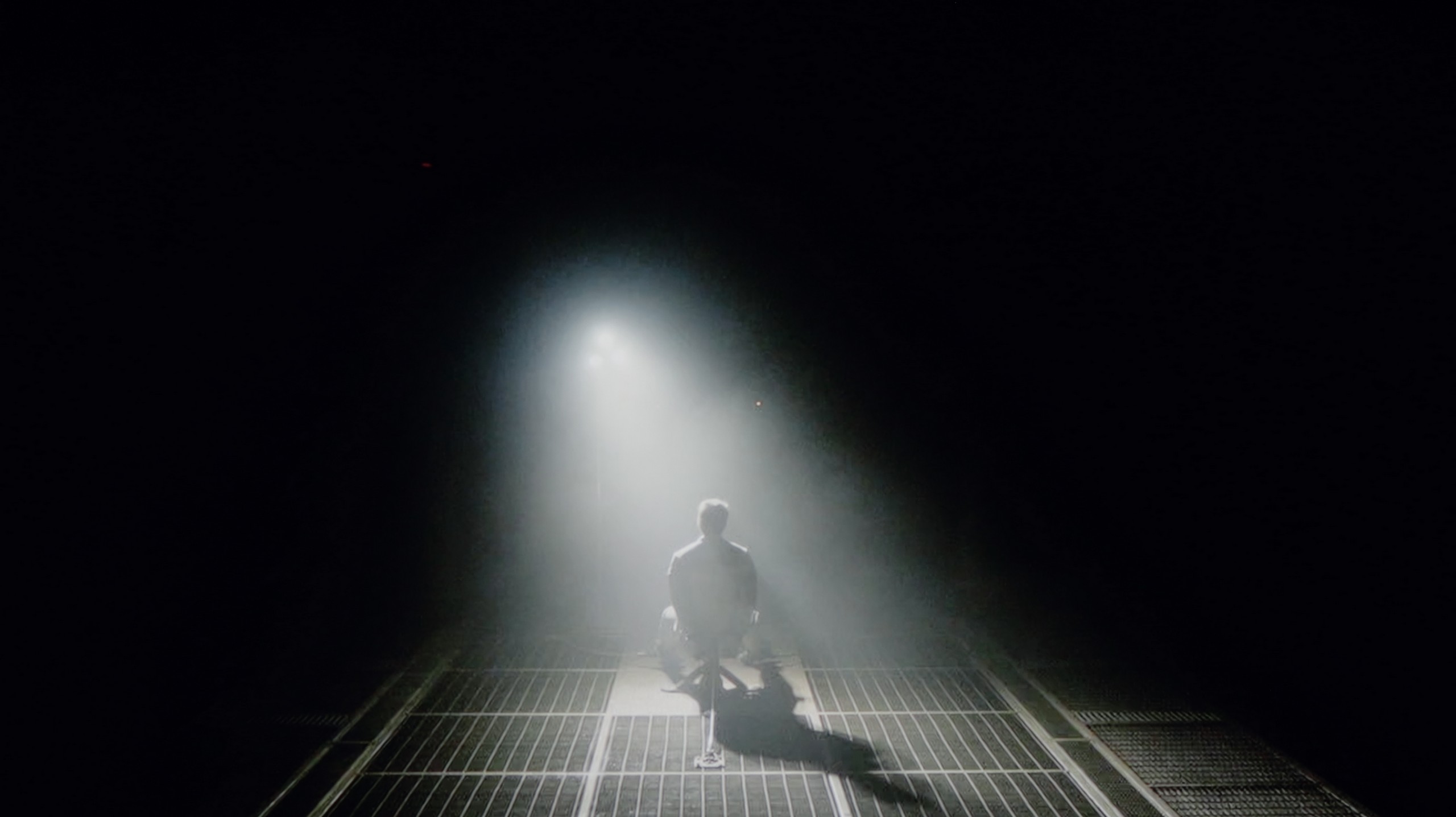
The QN70F is equipped with a VA panel that offers high native contrast – this is already a good starting point for blacks, especially for evening viewing. But theoretically, this does not end its capabilities. The television is branded as Neo QLED, which means the presence of Mini LED technology and a local dimming system. And indeed – the QN70F has such a function. The problem is that we are not talking about classical local dimming with LEDs placed directly behind the panel. Instead, edge lighting is used with a full-screen dimming mechanism known as global dimming. The effect of this is that instead of selective brightness control in individual zones, the entire screen is slightly dimmed when a dark scene appears. In practice, this means that the contrast is average compared to Mini LED models that offer true local dimming. The black level is not bad – it's thanks to the VA panel itself – but we cannot speak of precise light control that advanced systems with multiple zones provide. And here comes the question: is the QN70F series television really a Mini LED TV, or just a marketing variation on the Q70 series? Looking at the technical aspects – it is hard to consider this model a full-fledged representative of this technology. However, in everyday use, the black level looks decent and may be fully satisfying for many people.
I must admit, when approaching a receiver in this price range, one instinctively crosses their fingers, hoping that at least the black won't be a gray blot. Meanwhile, the Haier Q80FUX, specifically the 55-inch model present in our editorial office, can very positively surprise in this regard. Its secret lies in using a VA panel, which by nature has an inclination for generating high contrast. And these are not empty promises. During screenings, in most film shots, the contrast consistently reported levels from 5000:1, often reaching as high as 8000:1. These are really strong results, considering the fact that this television does not possess any, even minimal, form of local dimming. Translating this into couch experiences: given its price realities, the Q80FUX offers simply solid blacks. Of course, it's not that perfectly velvety depth that makes the screen disappear into darkness. When we conduct a screening in conditions of complete isolation from light, we will notice that in the darkest parts of the image, the black reveals its budget origins, slightly shifting towards a bluish tint. However, this is a defect easy to mask – just a little light from a lamp in the corner of the room is enough for this nuance to become invisible, and the image to regain a satisfying depth.
HDR effect quality
5.6/10
4.9/10
Luminance measurements in HDR:

Result
619 nit

Result
449 nit

Result
500 nit

Result
422 nit

Result
483 nit

Result
308 nit

Result
327 nit

Result
352 nit

Result
330 nit

Result
344 nit
Scene from the movie “Pan” (about 2800 nits)


Scene from the movie “Billy Lynn” (about 1100 nits)


Static HDR10


Dynamic: HDR10+
Dynamic: Dolby Vision


HDR luminance chart:
Haier Q80FUX
HDR luminance
Samsung Neo QLED QN70F / QN74F / QN77F
HDR luminance
QN70F is a TV that can positively surprise when it comes to brightness. In ideal test conditions, it reaches even 800 nits, which – for this price range – is really solid. Of course, that's a result from measurement test patterns, so we decided to check how it performs in practice, with real movies. Here, the TV somewhat tones down its capabilities. In most of the tested scenes – for example, in "The Meg" – the actual HDR brightness was around 500 nits. That's still a good result that allows you to enjoy HDR effects, although it is far from perfect. On the other hand, we have a QLED screen with a quantum dot layer, which means very good color reproduction capabilities. The colors are vivid and saturated. QN70F covers about 94% of the DCI-P3 color space, and in the wider BT.2020 gamut, it exceeds 75%, so in this regard, there's nothing to be ashamed of.
Alright, let's move on to the topic that generates so much discussion, namely the capabilities of the TV in HDR mode. Let's make it clear right away: the Haier Q80FUX is certainly not a brightness demon. The panel of this receiver can generate about 350 nits at peak, which in today’s reality is an absolute minimum to even talk about the presence of extended HDR tonal dynamic range. On the plus side, this power is at least stable – regardless of the test pattern or movie scene we used, the measurements invariably oscillated around 300-350 nits. These are therefore at best adequate results, definitely far from the stunning showcase of capabilities that we know from more expensive models. Fortunately, there is one aspect in which the Q80FUX makes up for these shortcomings and does so abundantly. After all, we are talking about a QLED TV (or more precisely, PFS LED), which means that thanks to the quantum dot filter applied to the matrix, it can generate really juicy, vibrant colors. These are not empty promises – a DCI-P3 color gamut coverage reaching nearly 95% is an impressive result that directly translates into very pleasant, saturated colors for the eye.
Factory color reproduction
7/10
4/10


Factory Mode
After calibration
We tested the QN70F in the best default picture mode, which is Filmmaker Mode. It must be said that in this particular test unit, the factory settings performed quite well. The picture was calm, natural, and despite minor deviations, pleasant to perceive. The biggest flaw was a slight dominance of red in the white balance, which caused a slight pinkish tint to the entire scene. However, this was not a glaring flaw – rather subtle and only noticeable when directly compared to a properly calibrated screen. A somewhat larger issue appeared in the brightness characteristic. The television tends to understate the brightness of parts of the image that should be displayed more brightly. As a result, some details can appear slightly dimmed – not so much lost entirely, but not as clearly pronounced as they should be. Nevertheless, as far as a television in this category and in these settings goes, we consider the result to be a good starting point for further calibration.
Factory settings for film mode are rarely perfect, but in the case of the Q80FUX, we encountered a noticeable imbalance. In SDR content, the image was definitely too warm, which resulted from an excessive amount of red in the white balance, giving it a slightly sepia tone. Contrarily, in HDR materials, the television fell into the other extreme—the excess of blue created an unnatural, cold effect. However, it wasn’t the whimsical white balance that was the biggest problem with this TV. The real culprit, responsible for the previously described issues, was hidden deeper. It turned out that the Q80FUX had completely misaligned gamma values and, crucially for HDR, a poorly managed EOTF curve. It was these erroneous factory settings that caused notorious clipping of the brightest parts of the image, applying that characteristic milky filter over them. Thus, we found the source of the problem. This state of affairs led to overall, significant color errors that were easy to catch even for an untrained eye. Like every television we tested, we decided to calibrate this model as well, and you can find the results of those adjustments in the next paragraph.
Color reproduction after calibration
8.5/10
6.1/10




After calibration, the QN70F shows that it can offer a really high level of color reproduction. It nearly perfectly balanced the white point, and the values in the Color Checker test dropped below 3 – that is, below the threshold at which the average eye can perceive differences. The image looks natural, and the colors are accurately represented, without excessive saturation or the coolness known from factory settings. It must be said that Samsung provides very extensive calibration options – not only for enthusiasts but also for professionals. The QN70F takes advantage of this potential and, after proper adjustment, can come close to much more expensive models in terms of color accuracy. The only thing one could still criticize is the brightness characteristics. There is still a tendency to brighten the smallest parts of the image – particularly those that should remain darker. However, this is a design feature of this model, not a calibration error. Despite this, the final effect definitely deserves recognition.
The results of our calibration efforts must, unfortunately, be considered twofold. Overall, the image is indisputably better than before the corrections, but the biggest winner of this process turned out to be SDR content. It is here, after clarifying the gamma and white balance graphs, that we obtained results that can confidently be called very good. After the setup, the Q80FUX truly shines in standard dynamics, showing only slight errors in the most challenging skin tone reproductions. Unfortunately, the weakest link still remains HDR content. And here lies the paradox: even though we managed to calibrate the white balance almost to perfection, the overall color errors still remain at a fairly high level. The reason is that the television still interprets the static HDR10 metadata "in its own way," stubbornly enforcing that unfortunate washed-out image effect, which inevitably leads to significant distortions. Although we successfully eliminated the factory excess of blue color, due to this electronic interference, the screen can still tend to fall into somewhat too cold tones. This television just has it this way.
Smoothness of tonal transitions
9/10
7.5/10












In terms of tonal transition fluidity, the QN70F performs really well. The gradients are smooth, and the colors blend into each other without noticeable thresholds or banding. Even in more challenging film scenes – especially very dark ones – any imperfections are minimal, and you really have to focus to notice them. In everyday viewing, most users should not encounter any issues with color blending. The image looks clean and coherent, without artificial smoothing or distortions. This is another aspect where the QN70F pleasantly surprises.
Analyzing the television's ability to handle subtle tonal transitions, known as "banding," leads us to interesting conclusions. The Haier Q80FUX skillfully blends neighboring colors in most scenes, creating a smooth, cohesive image. However, this is not an ideal process. During the tests, we noticed minor issues and imperfections in every test scene we used. These are perhaps not errors that aggressively catch the eye and spoil the movie experience, yet their presence is worth noting. Interestingly, this receiver shows no particular weaknesses or strengths in this regard – it handles this challenge exactly the same, whether displaying delicate gradients of a bright sky or dark transitions in shadows.
Image scaling and smoothness of tonal transitions
6.9/10
4/10
Smooth transition function
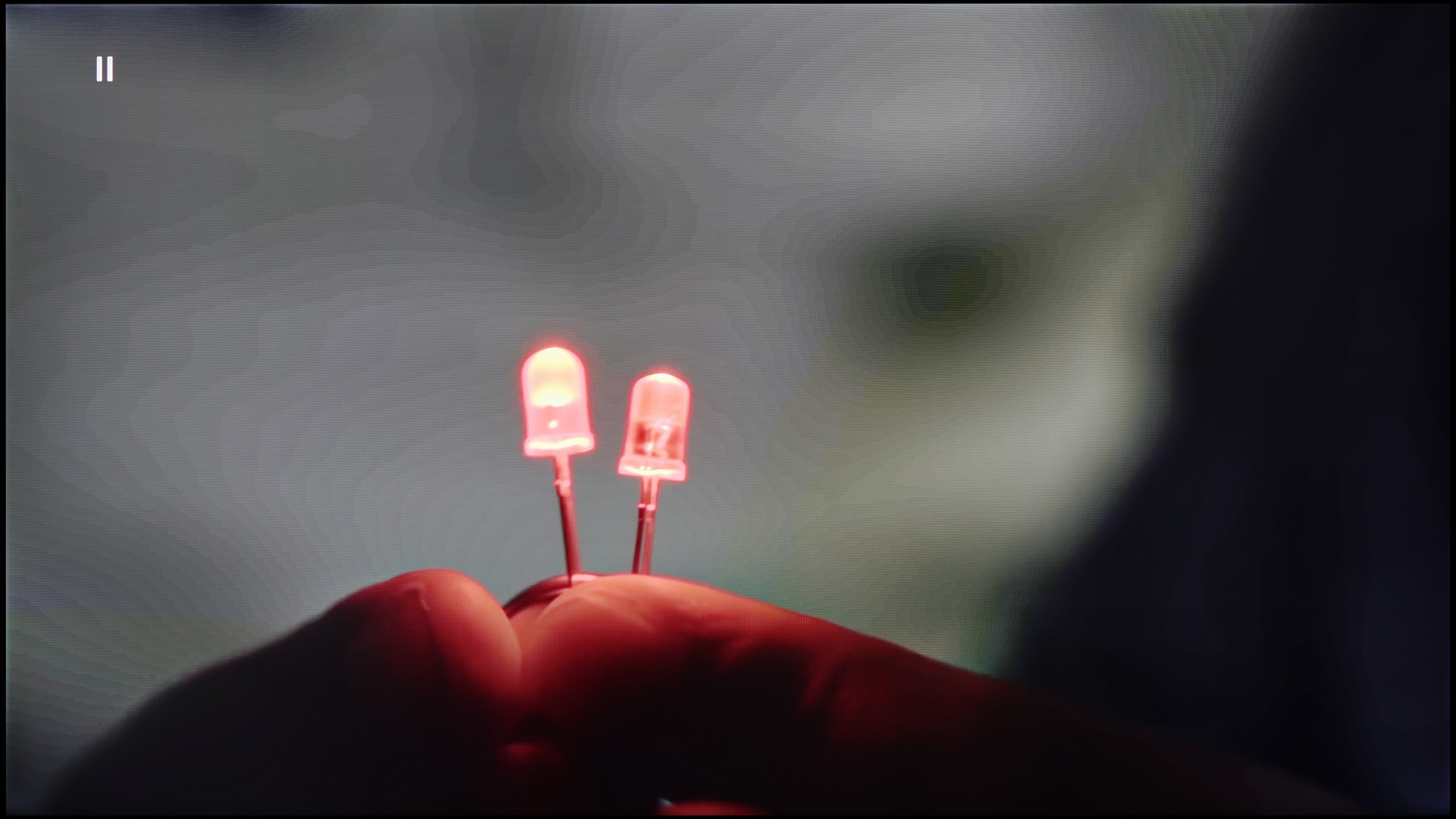
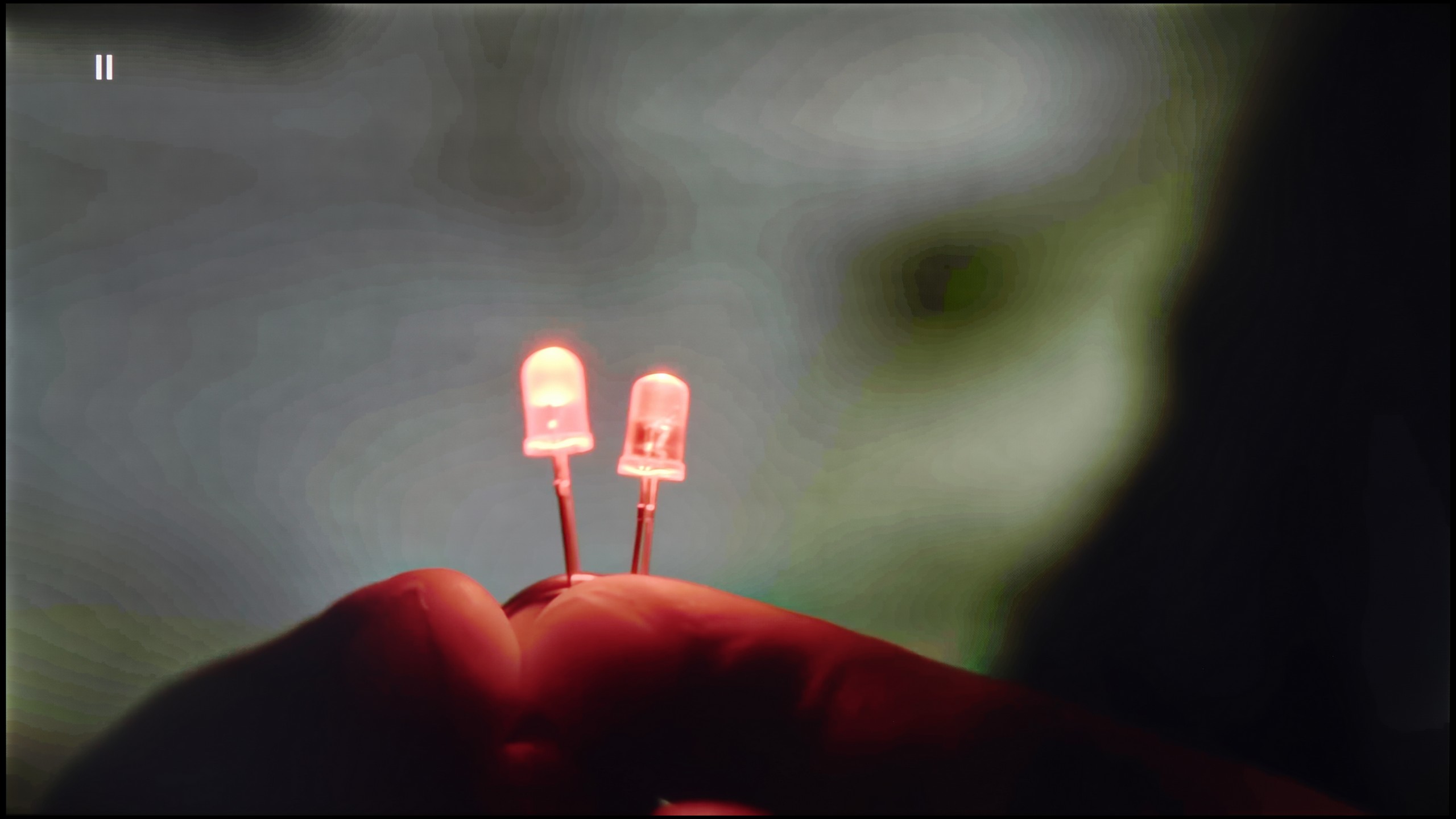
Image without overscan on the SD signal


Samsung QN70F offers a distortion reduction feature that improves the smoothness of tonal transitions. In "Standard" mode, it works quite well - smoothing problematic transitions without significantly interfering with the image structure. Film grain is partially removed, but details such as texture or skin structure still remain visible. The "High" mode operates much more aggressively. The smoothing is stronger, but it comes at the cost of a noticeable loss of detail. Therefore, in practice, we recommend sticking with the "Standard" setting or completely turning off this feature. The improvement in gradation may be less spectacular, but the image retains more naturalness.
When it comes to scaling low-quality content, the QN70F performs very well. Tests with lower resolution images were really impressive. Despite slight aliasing of contours, everything looks clean and clear, even if the original content was very poor. It's just a shame that the TV has an overscan issue that cannot be completely turned off. As a result, the image from very low resolution may be slightly cropped, which is mainly visible on subtitles or the interface.
If there is one area where Haier clearly shows that it has quite a bit to catch up on compared to the market leaders, it is digital image processing. The upscaling, well... is just okay. And that's about all that can be said about it. It does what it is supposed to do: it ensures that lower resolution signals don't scare you with harsh pixelation on the screen and don't look like an overly enlarged postage stamp. However, it is far from the finesse and "intelligent" sharpening that more experienced players in this market have developed over the years. The biggest drawback of the Q80FUX software, however, is the almost complete lack of additional "cleaning" and smoothing functions for the image. The receiver does not offer any noise reduction or gradient enhancement mechanisms. This means that with older or more heavily compressed materials, we simply have to accept that any imperfections in tonal transitions or color blending, which we mentioned earlier, will constantly accompany us during the viewing.
Blur and motion smoothness
7.5/10
4.5/10

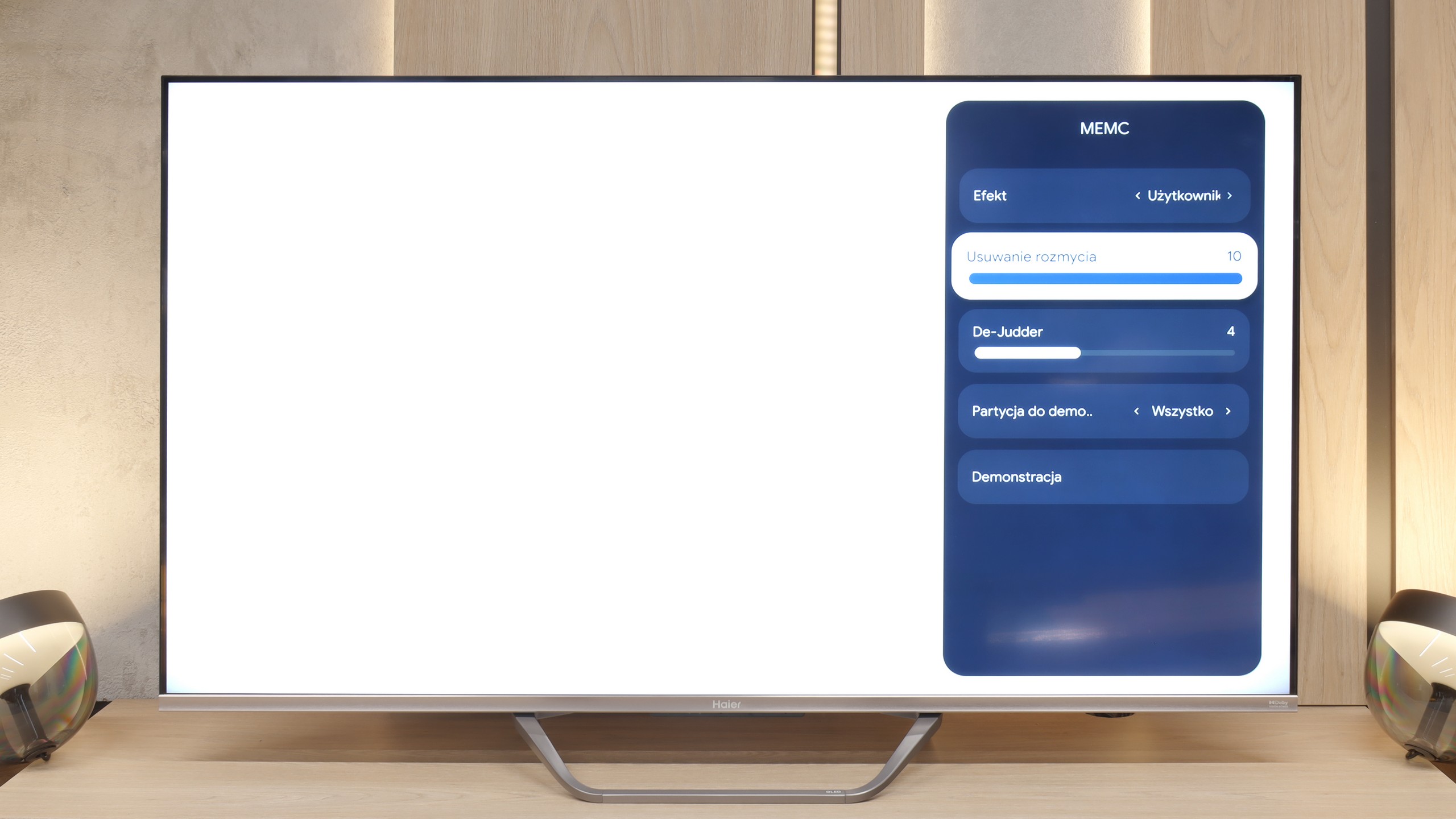
Blur (native resolution, maximum refresh rate):
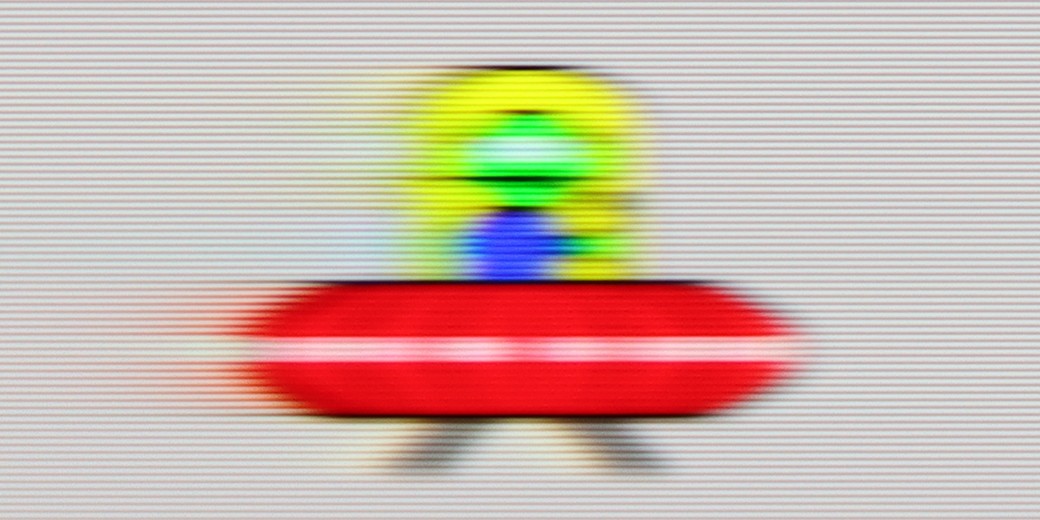
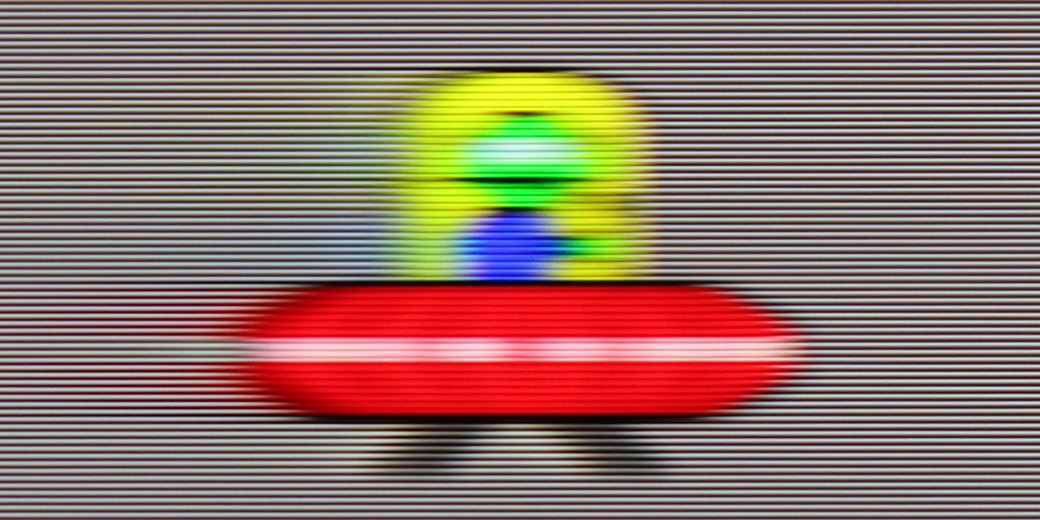

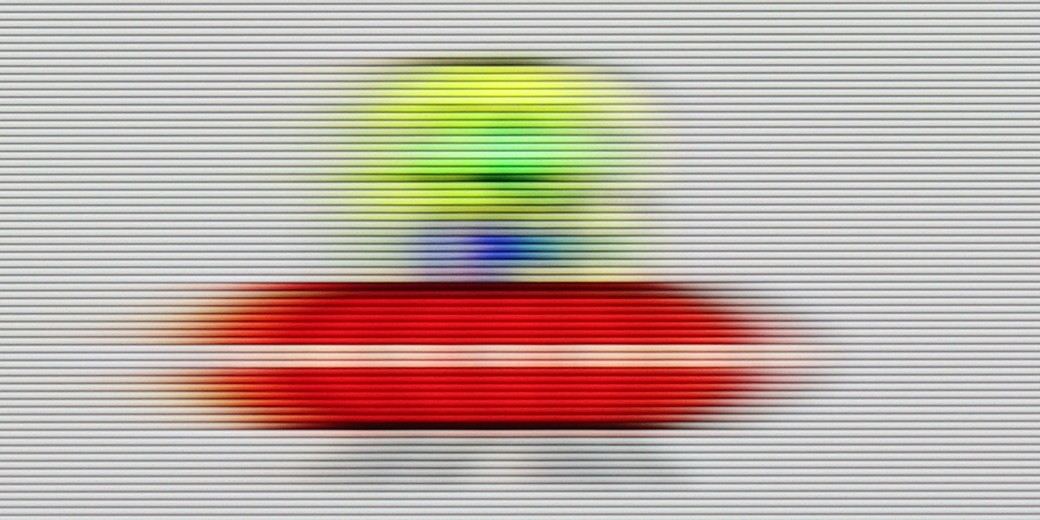
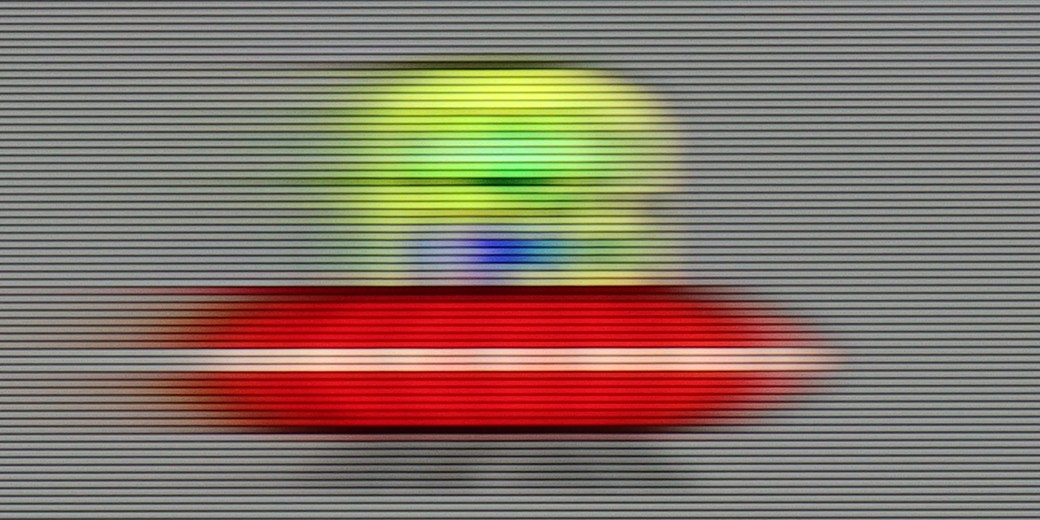
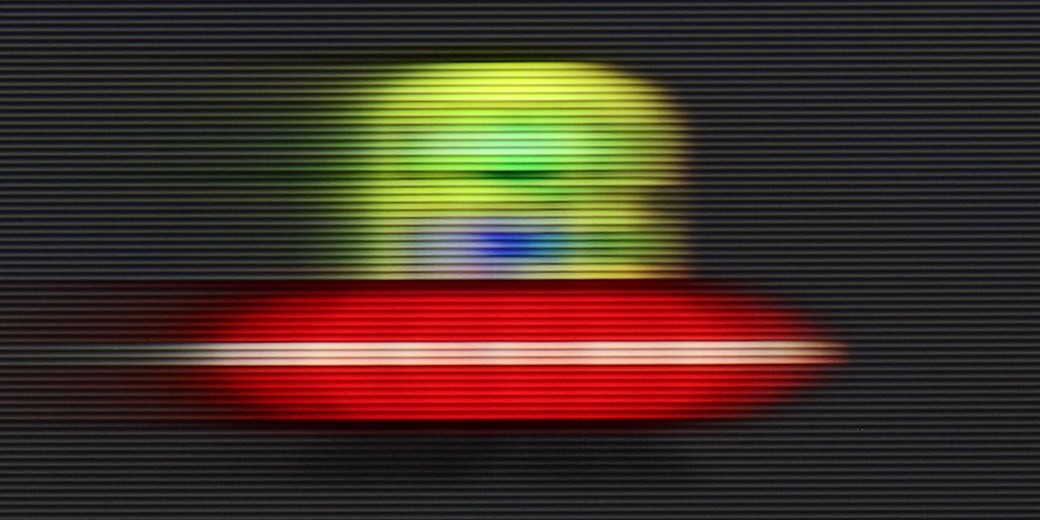
Blur (BFI function enabled):
Image flickers in this mode



Smużenie (4K 144Hz):

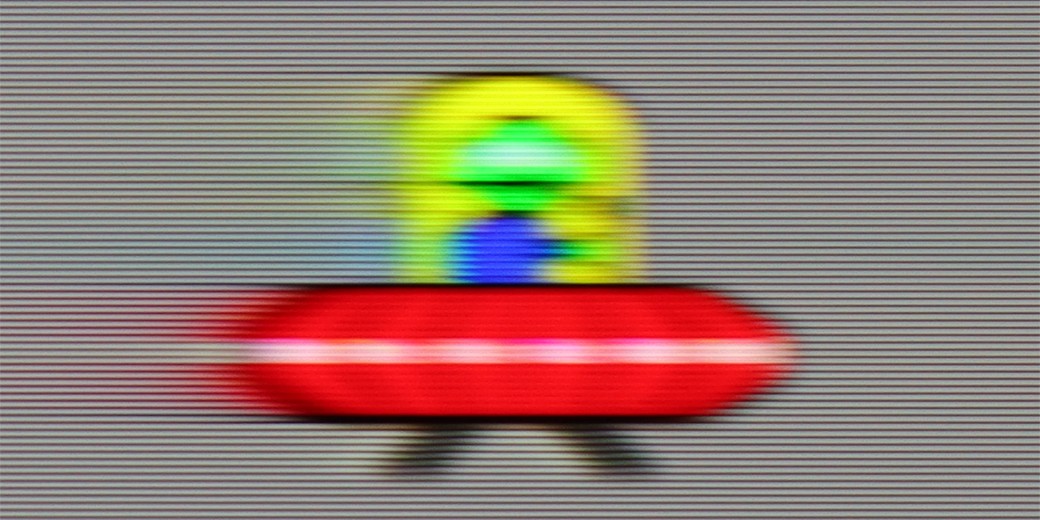
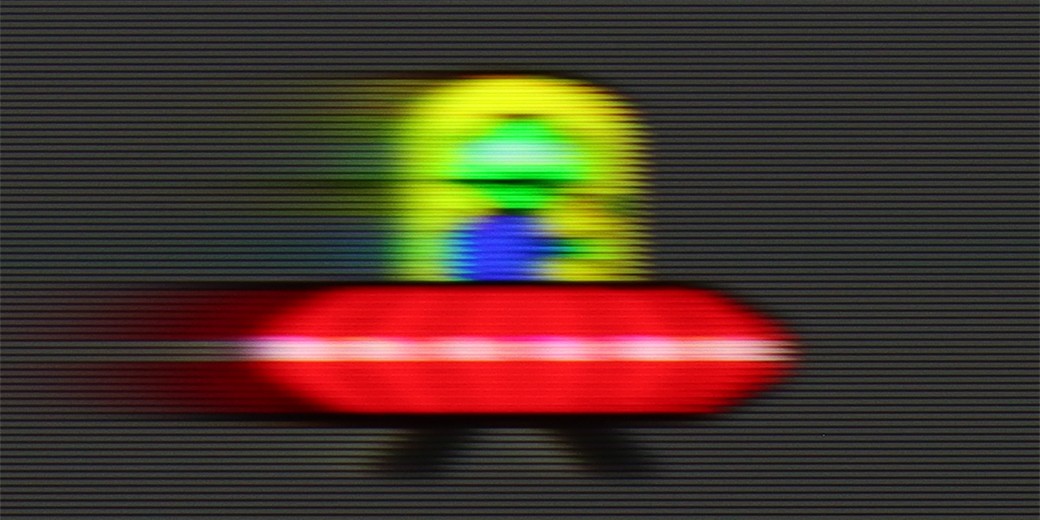
Smużenie ():
The QN70F is a television with a refresh rate of 144 Hz, which puts it at the forefront in terms of image smoothness. Whether we are watching dynamic sports broadcasts or playing on a console, the picture looks very good. There is no feeling of stuttering, chopping, or the typical "tearing" in fast motion that is common in lower-end models. Samsung also allows you to adjust the smoothness to your own preferences. In the picture clarity settings, we find options such as blur reduction and motion smoothing – each of which can be adjusted independently. This is especially useful when watching content with a lower frame rate and we want to give it a smoother, more cinematic character – or on the contrary, maintain the natural film "feeling" of 24 frames.
The issue of motion fluidity and blurring is largely predetermined by the use of a 60Hz panel, which naturally makes it difficult to recommend this receiver to enthusiasts of very dynamic content. Fortunately, in the Q80FUX, we find a few options (though, as we will see shortly, actually only one) designed to improve the experience with older film productions. There is a "De-Judder" slider available, which indeed affects the smoothness of the image and allows us to adjust it to our preferences: from raw, cinematic frame rates to a more theatrical, smoothed presentation. However, a genuine surprise awaits us right next to it in the menu. There is also a second slider, supposedly dedicated to eliminating blur – this is a feature we usually encounter in 120Hz panels, aimed at combating motion blur in sports. However, as expected, recalling memories from testing the K85F model, here too this slider is merely a facade. Moving it does absolutely nothing to the image and it simply looks like an oversight by the product engineers who left a non-functional option in the software for this type of panel.
Console compatibility and gaming features
8.2/10
5.6/10
- ALLM
- VRR
- VRR range48 - 144Hz48 - 120Hz
- Dolby Vision Game Mode
Yes, high input lag
- Correct implementation of HGIG
- 1080p@120Hz
- 1440p@120Hz
- 4K@120Hz
- Game bar
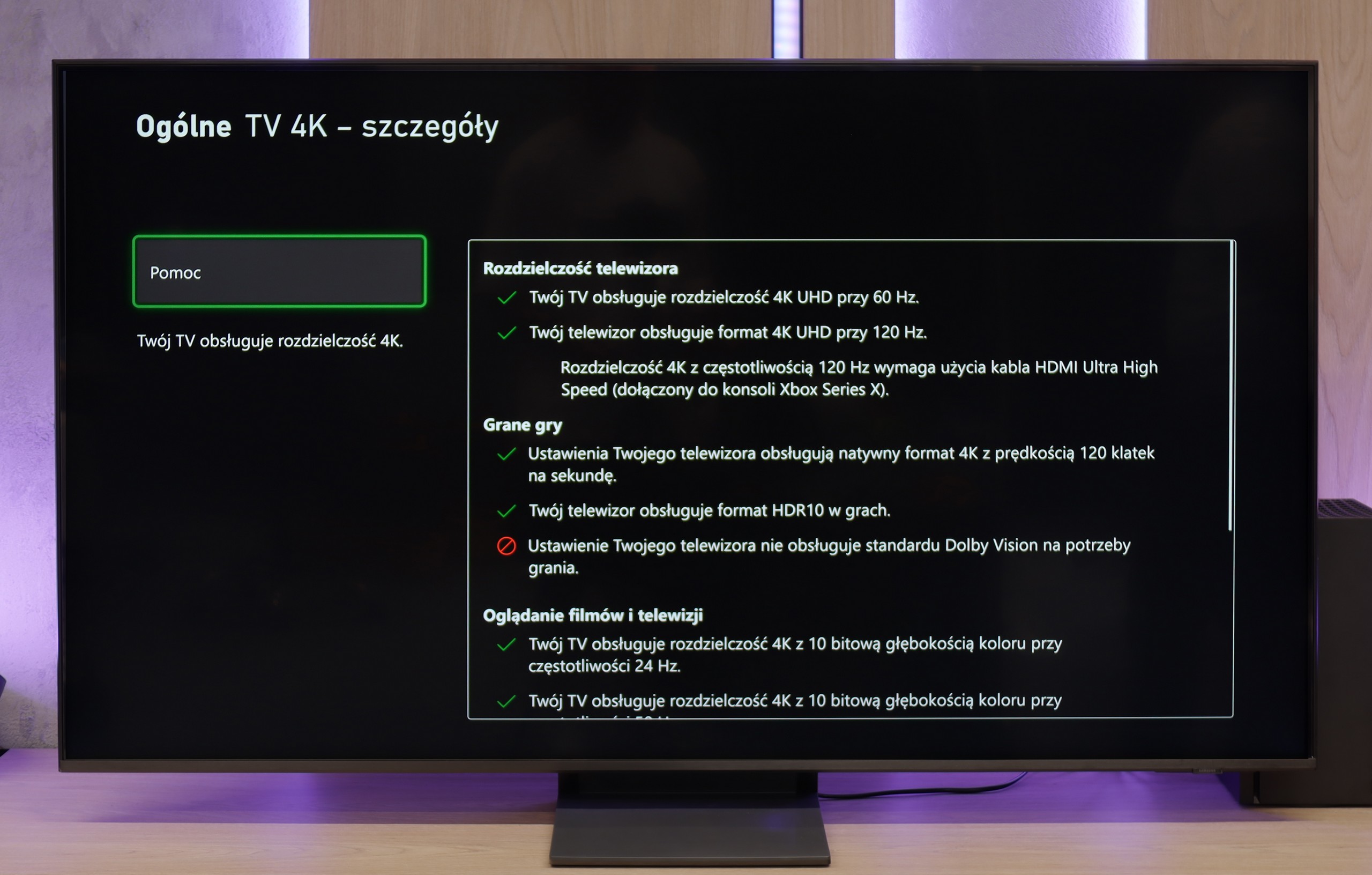
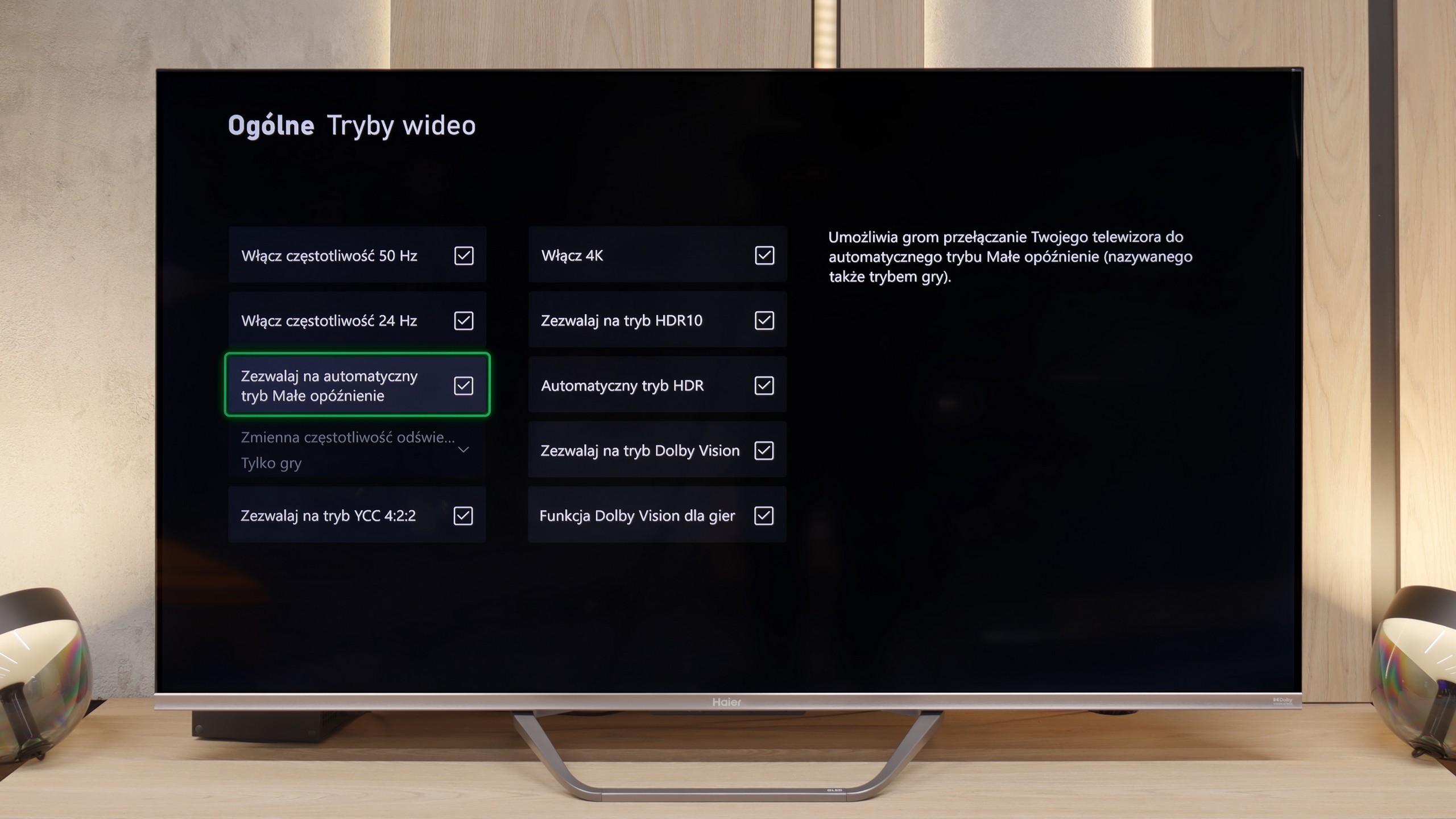

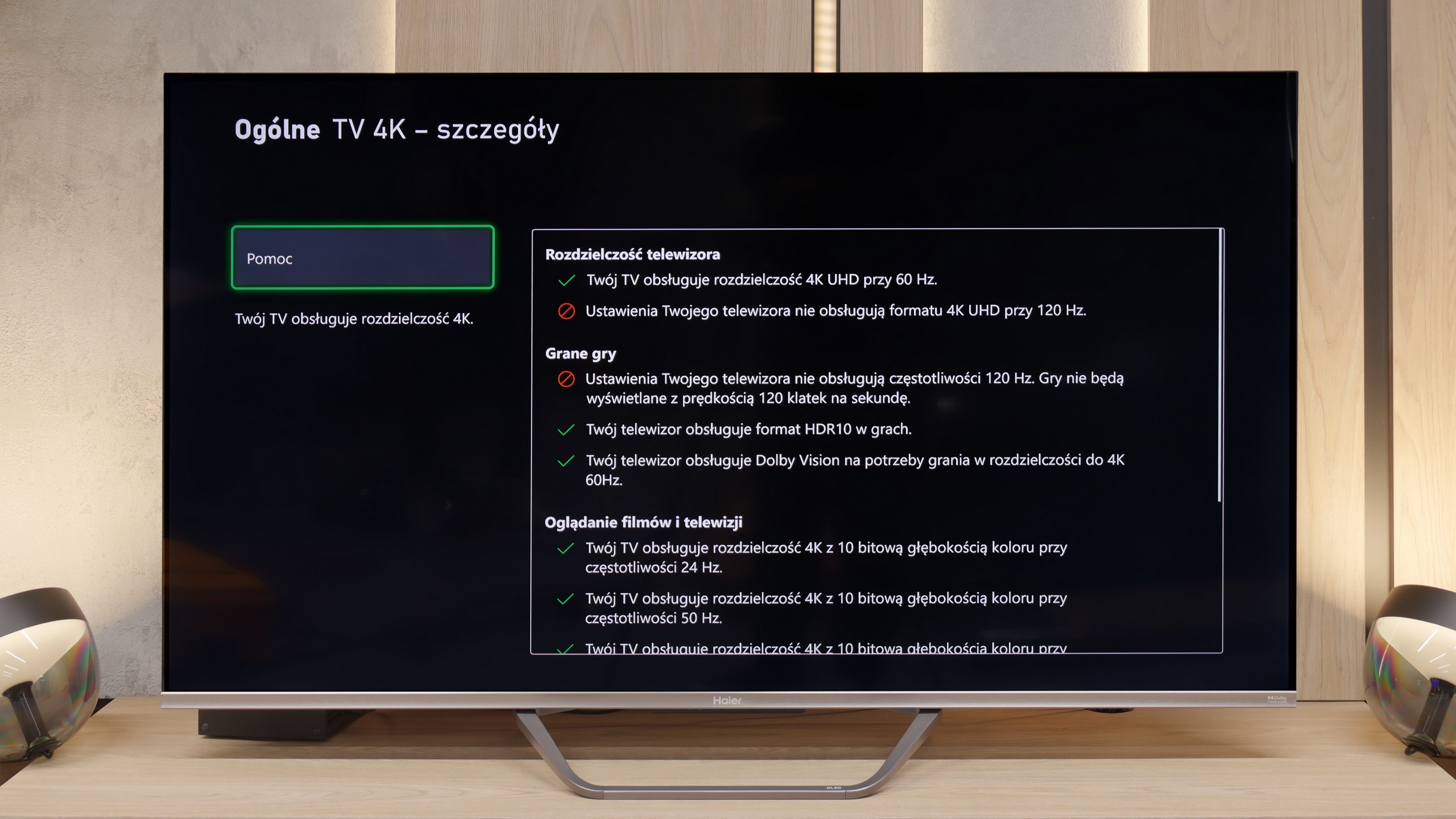
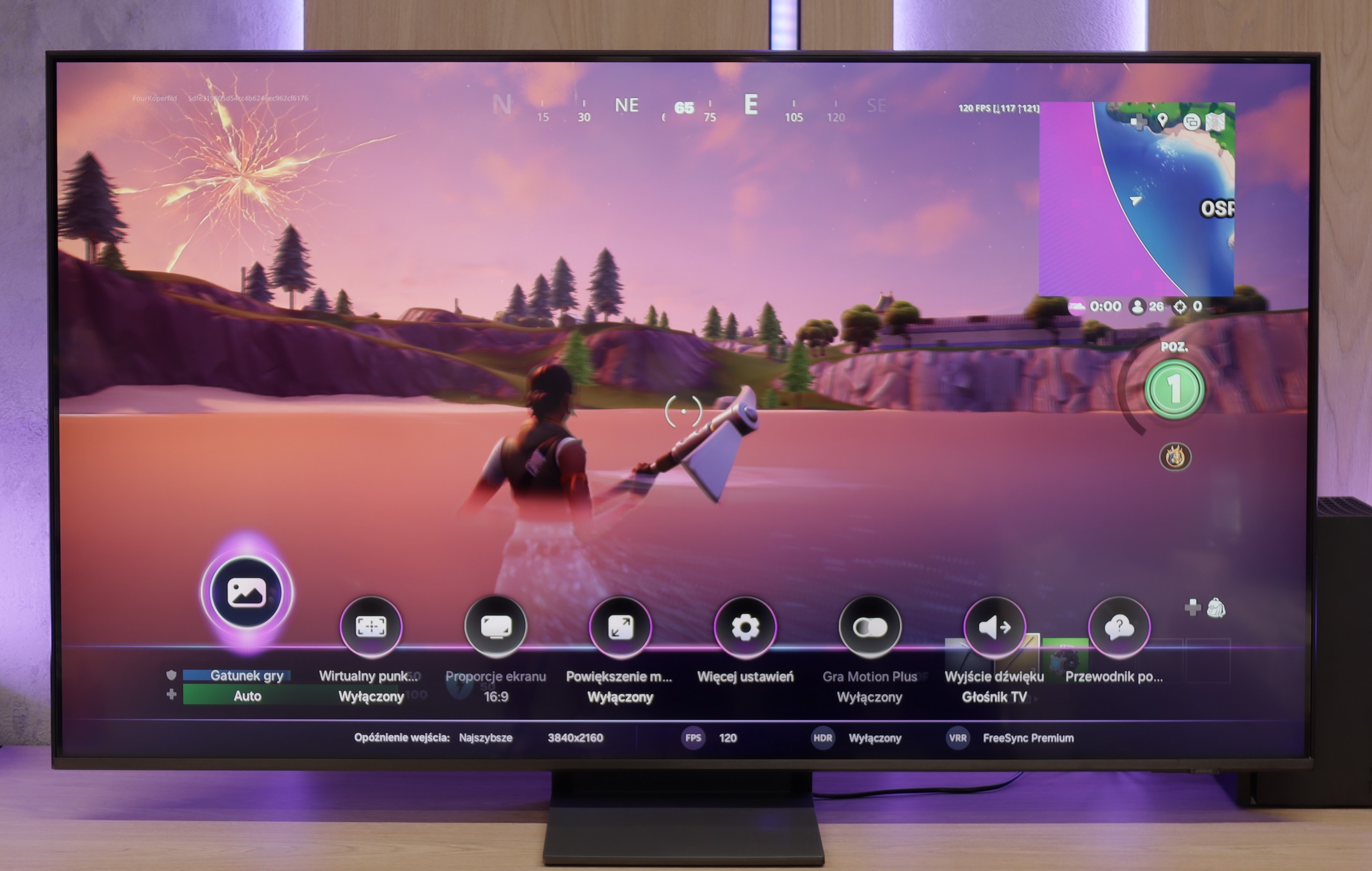



Samsung QN70F is truly a solid choice for gamers. Here we have as many as four HDMI 2.1 ports with full bandwidth of 48 Gbps, which means full support for gaming in 4K at 144 Hz refresh rate. In addition, we have all the basic features we expect today: auto low latency mode (ALLM), variable refresh rate (VRR), and a very well-designed, intuitive Game Bar with information about the mode, resolution, and frame count.
It's also worth highlighting the Game Motion Plus feature, which allows you to add artificial frames to games running at 60 fps or less. It works surprisingly well and in many titles – especially those where consoles struggle to maintain a stable framerate – it improves gameplay smoothness without significant lag.
Unfortunately, there are also some drawbacks. The lack of support for Dolby Vision mode is not surprising – it's a standard for Samsung. But the much bigger disappointment is the absence of the HGiG feature. What's worse, it was removed in a software update, leaving users who previously used it quite shocked. Without HGiG, you can't manually set the maximum HDR brightness from the console, which results in some games looking slightly washed out – especially if the TV misinterprets the tonal range. Why did Samsung, a brand that has set standards in gaming features for years, decide to take such a step? It's hard to say. At the time of writing this review, the tested TV was running on software version 1110 – and frankly, if you care about full support for gamers, it's better to temporarily hold off on updates.
Stepping into the gaming territory, the Haier Q80FUX proves to be quite a decent companion for the "casual gamer." On board, we find today’s highly desired features like VRR (variable refresh rate) and ALLM (automatic low latency mode). However, the biggest surprise is something else. Although we are not dealing with a 4K@120Hz panel, the TV can accept and display a 120Hz signal at a lower resolution (Full HD). This is a very useful feature, allowing the conscious switch of the console to a lower resolution mode in exchange for significantly higher fluidity, which is a perfectly acceptable compromise in the gaming world.
We won’t particularly complain about the lack of extras like the "Game Bar," as it’s just a nice addition. The most concerning issues arise when we enter the world of HDR in games. Due to the fact that the TV constantly adapts the signal "in its own way," setting the brightness on the console according to the HGIG standard is nearly impossible to accomplish as per the instructions. Worse still, in the Dolby Vision mode for games, the input lag rises to about 50 ms, which is a high enough value that essentially makes this mode unusable. However, generally, we wouldn’t recommend gaming on this TV in HDR mode, so these aren’t such serious shortcomings. The most pleasing aspect is the presence of 120Hz in Full HD, which makes the Q80FUX quite a nice TV for the occasional gamer.
Input lag
10/10
9.4/10
SDR
HDR
Dolby Vision
QN70F does not disappoint in terms of response time either. For 120 Hz materials, input lag stays around 8 ms, which can be considered a very good result – especially in the context of online competition or fast-paced action games. The screen responds to controller movements almost instantly, without any noticeable delay. This allows for smooth and comfortable gameplay, even in more demanding titles. In this category, Samsung still maintains a high standard, and it’s hard to find anything that could raise concerns.
If there is one category in which the Haier Q80FUX absolutely shines and shows its claws, it is input lag. In this area, the television presents results that are truly remarkable. In 120Hz mode (achieved, let’s remind ourselves, at a lower resolution), the input lag drops below 10 ms, which is an excellent value, worthy of high-end gaming monitors. Not much worse, and still at a very good level, is the classic 60Hz mode – here measurements steadily indicated around 12-14 ms. These are results that even significantly more expensive, gaming-specific designs would not be ashamed of. The only, but serious, drawback here is the Dolby Vision mode. As we established earlier, activating it raises the lag to an unacceptable level, so we definitely advise against using it during any interactive gameplay.
Compatibility with PC
8.2/10
6/10


Let's start with the best aspect when it comes to connecting the QN70F to a computer – that is gaming. The 144 Hz refresh rate, support for G-Sync compatible VRR, and very low input lag are the recipe for an almost perfect screen for PC gamers. In this role, the QN70F truly does not disappoint – games look smooth, responsiveness is at a very high level, and everything operates stably.
However, the performance when it comes to text work is somewhat lacking. At a 4K resolution and 144 Hz refresh rate, there is a noticeable lack of sharpness in the text outlines – the text can appear slightly blurred, with a slight "layering" of the outlines. This is not a problem that disqualifies the usability of the QN70F as a monitor, but those planning to do office work or text editing on this screen should keep this in mind.
We also checked how the Q80FUX works when connected to a computer. And here’s another pleasant surprise – it handles this really very well. The most important thing is that the fonts are very readable, so nothing blurs and you can work on it normally. Additionally, just like with consoles: we can set a lower resolution here to achieve a high refresh rate of 120Hz in return. What’s super important is that in this mode, G-Sync started up and worked correctly. This just confirms that this television is really a successful and efficient piece of equipment for gaming, including on a PC.
Viewing angles
3.1/10
3.3/10
As for the VA panel, the viewing angles on the QN70F are typical – meaning rather average. The image quickly loses contrast and saturation when we start looking at the screen from a sharper angle. Compared to IPS panels, it's definitely weaker. On the other hand – it is precisely because of this panel that we gain better black levels and higher contrast when viewing straight on, which for many users will be more important than wide visibility from the sides.
Anyone planning screenings with a wide, family group must be aware of the fundamental compromise that Haier has opted for by implementing a VA panel in this model. This technology has indeed provided us with deep blacks and high contrast, but its inherent feature is also a noticeable narrowing of viewing angles. Just sitting a bit further to the side on the couch is enough to immediately notice how colors begin to lose saturation and the picture fades. It’s simply a classic trade-off – we gain something (contrast) at the expense of something else (angles) – and the Q80FUX fits perfectly into this scheme.
TV efficiency during daytime
6.3/10
4.8/10

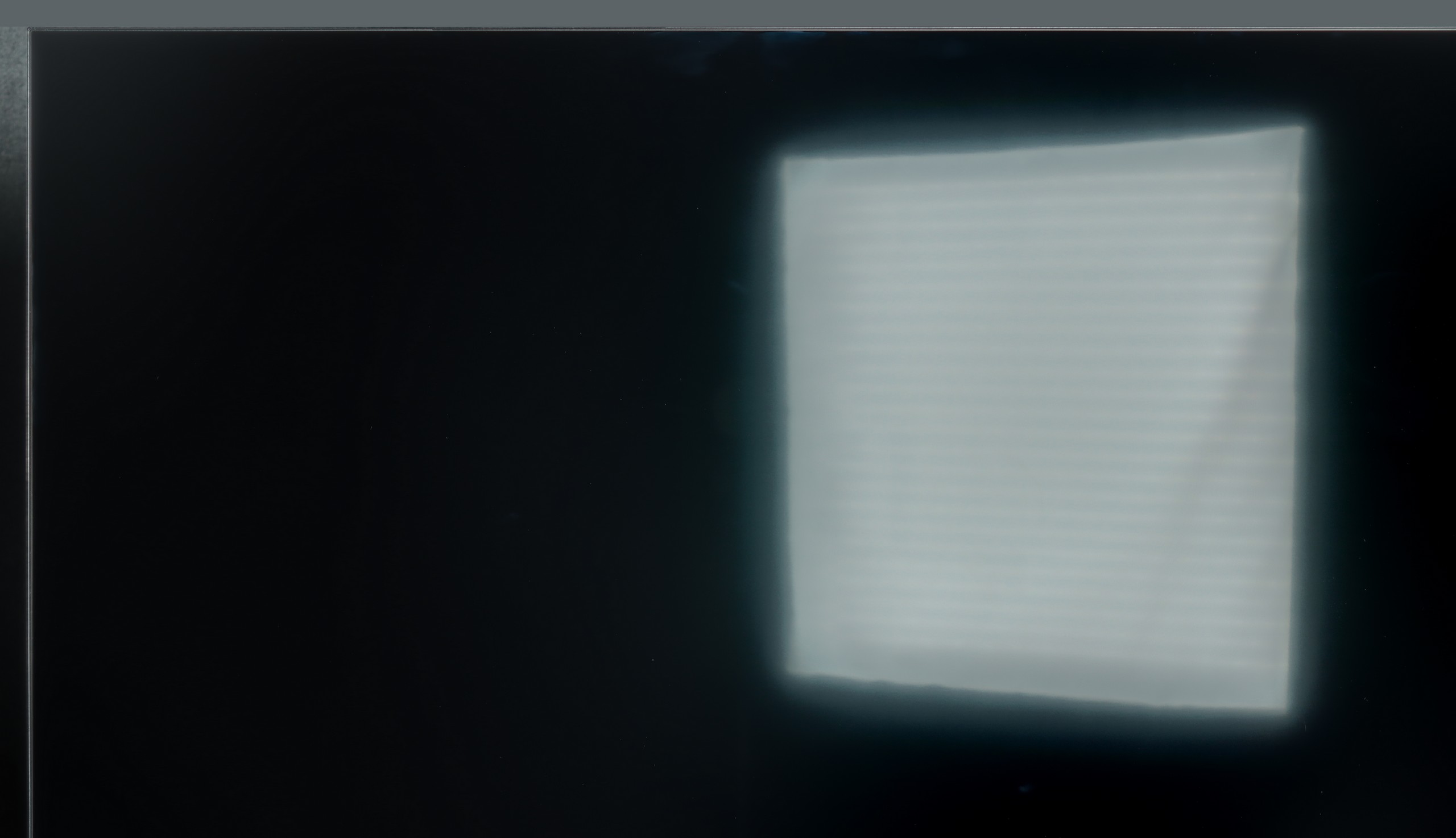


Matrix brightness
Average luminance SDR
Haier Q80FUX: 317 cd/m2
Samsung Neo QLED QN70F / QN74F / QN77F: 492 cd/m2
The QN70F handles a bright living room without any problems. The screen has a satin finish that effectively reduces reflections, so there's no need to immediately draw the curtains to see something. Even when there’s a lot of light in the room – for example, near a window on the side – the image still looks sharp and colorful. Brightness is also at a solid level. In SDR mode, the television averages around 500 nits, which is more than enough for daytime viewing. It may not be at the level of top models, but in practice – for everyday watching of TV, sports, or YouTube – it performs very well.
The clash of the receiver with the everyday challenges posed by a bright living room turns out to be quite decent in the case of the Q80FUX, although it is certainly hard to call it ideal. The matrix itself is equipped with a coating that handles the suppression of most ambient reflections fairly well. Equally importantly, even in more challenging lighting conditions, the screen is capable of maintaining pleasantly saturated colors. However, the weakness of this construction reveals itself where the power of the backlight comes into play. The previously mentioned, rather moderate maximum brightness (around 350 nits) means that when confronted with intense natural light coming through the window, the screen often struggles to "break through." On a sunny day, the image may simply lack the necessary expressive power.
Details about the matrix
Subpixel Structure:
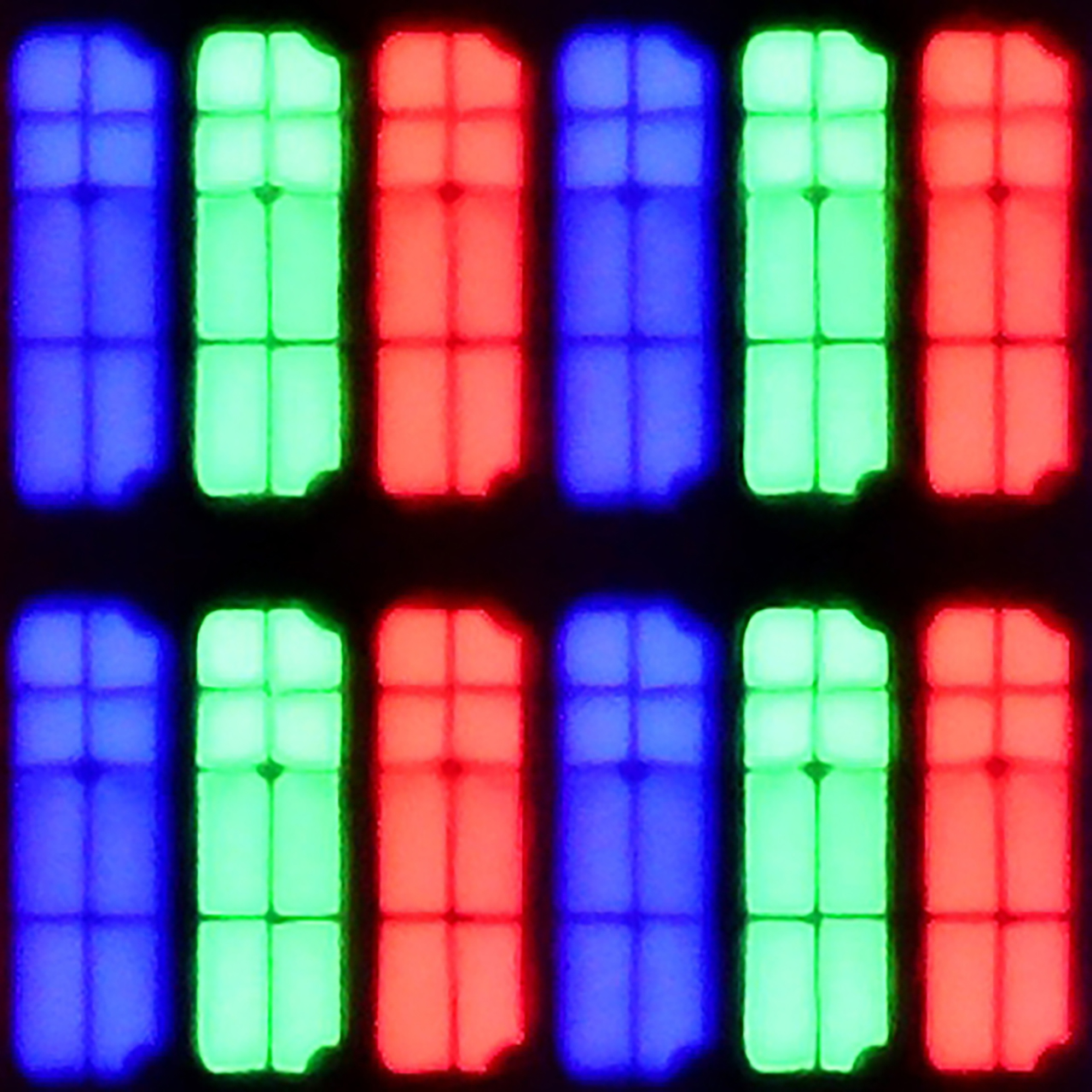
Panel uniformity and thermal imaging:


Samsung Neo QLED QN70F / QN74F / QN77F
Haier Q80FUX
TV features
7.2/10
5.6/10
- HDMI inputs0 x HDMI 2.0, 4 x HDMI 2.1 48Gbps4 x HDMI 2.0, 0 x HDMI 2.1
- Other inputsRCA (Chinch)
- OutputsToslink (Optical audio), eARC (HDMI), ARC (HDMI)Toslink (Optical audio), eARC (HDMI), ARC (HDMI), Mini-Jack (Headphones)
- Network InterfacesWi-Fi 2.4GHz, Wi-Fi 5GHz, Ethernet (LAN) 100MbpsWi-Fi 2.4GHz, Wi-Fi 5GHz, Ethernet (LAN) 100Mbps
- TV receptionDVB-T, DVB-T2, DVB-S, DVB-S2, DVB-CDVB-T, DVB-T2, DVB-S, DVB-S2, DVB-C
Classic features:
- Recording to USB (terrestrial TV)
- Recording programming
- Picture in Picture (PiP)
- RF remote control (no need to aim at the screen)
- Backlit remote control
- Teletext
- Audio only mode
- Bluetooth headphones support
- Simultaneous Bluetooth headphones & TV audio
Smart features:
- AirPlay
- Screen mirroring (Windows Miracast)
- Voice search
- Voice search in native language
- Ability to connect a keyboard and mouse
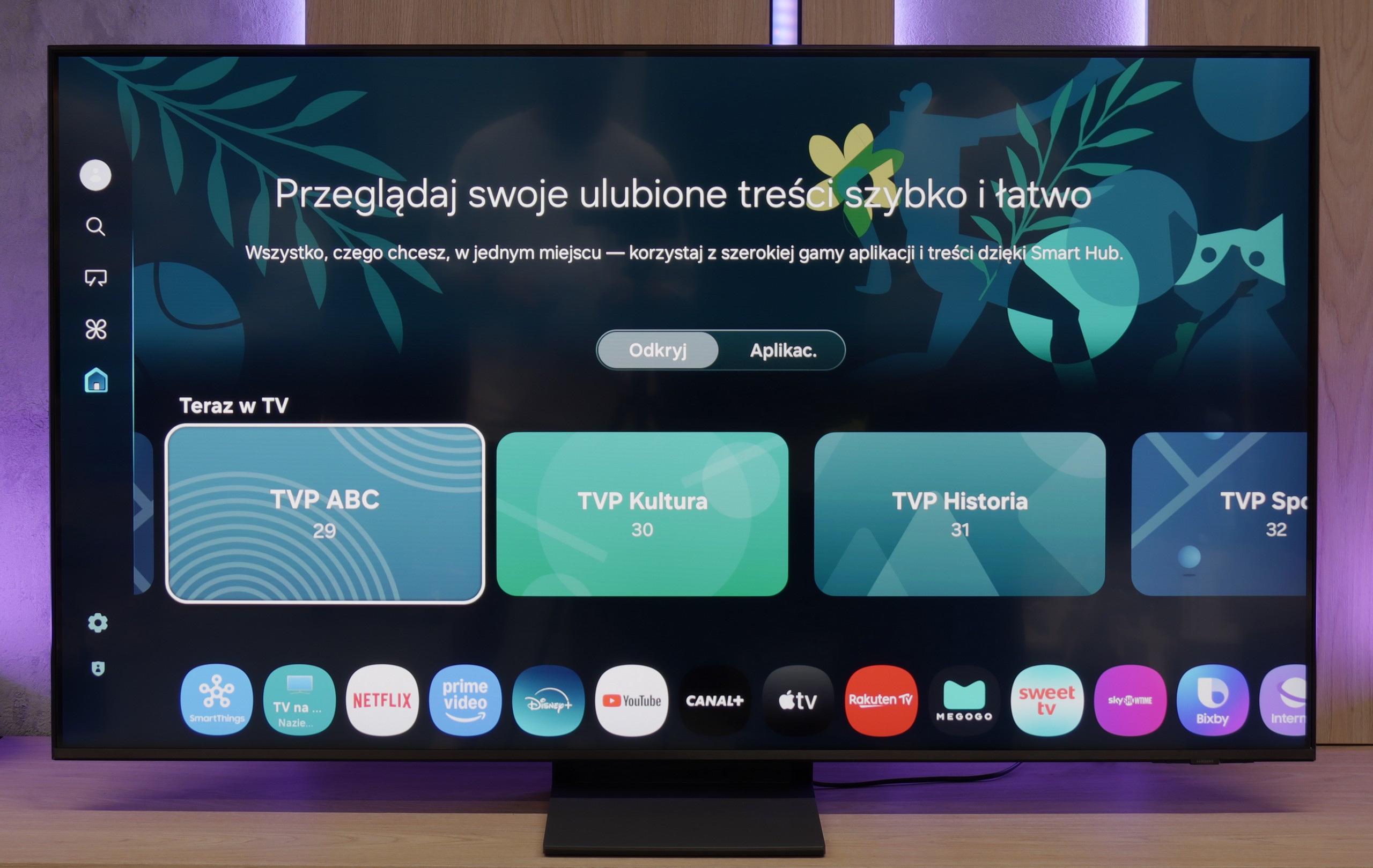


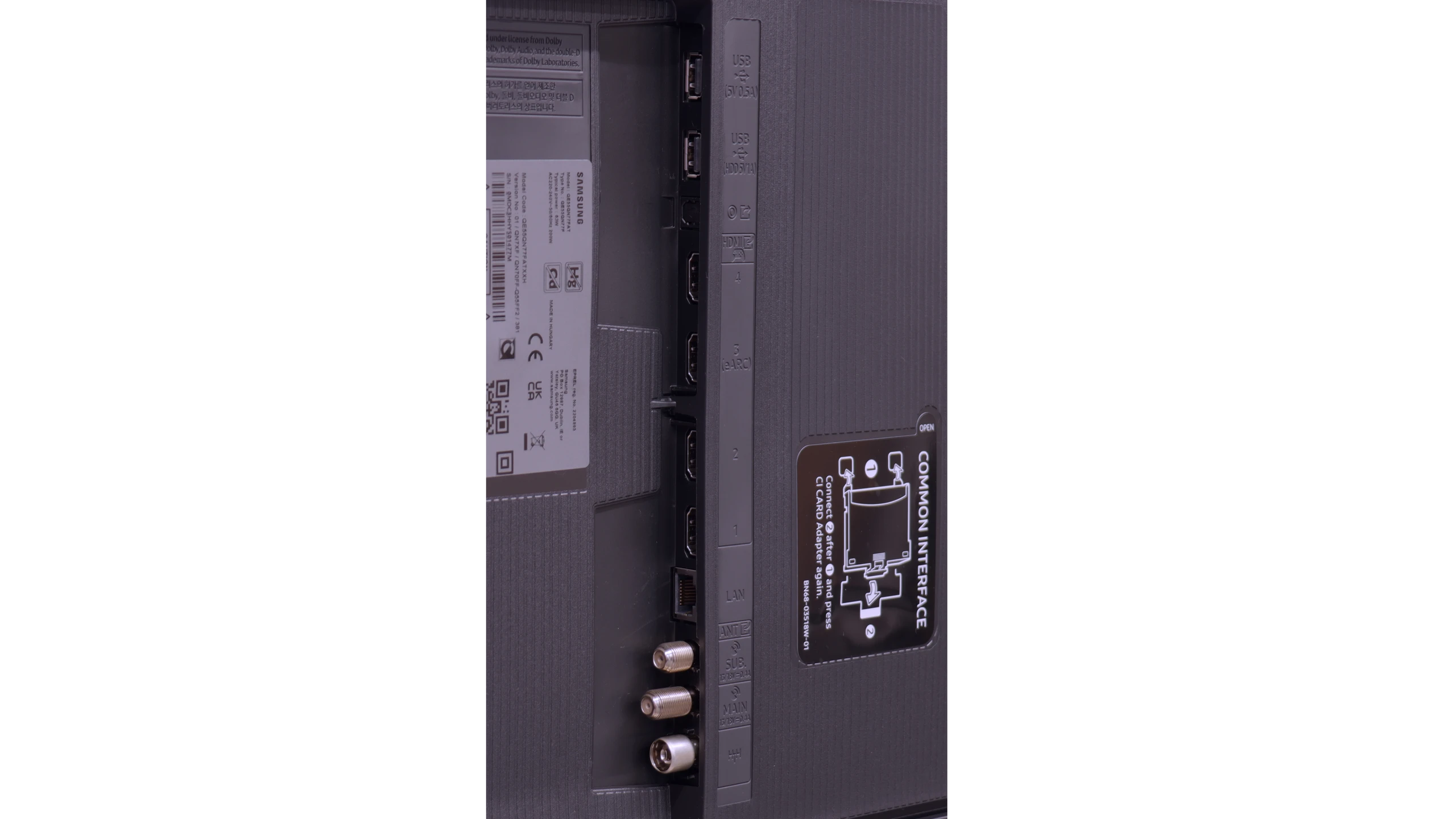
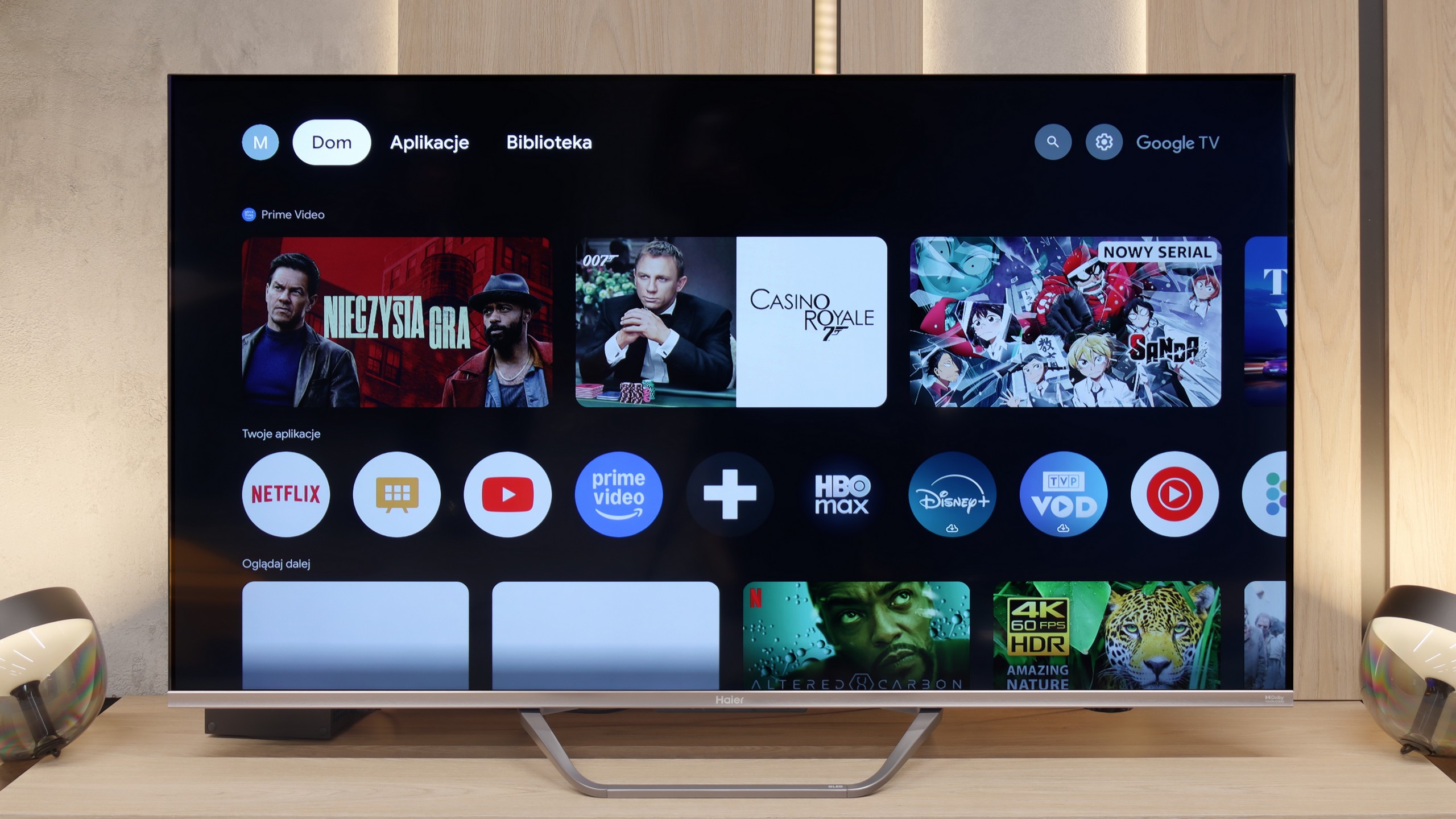
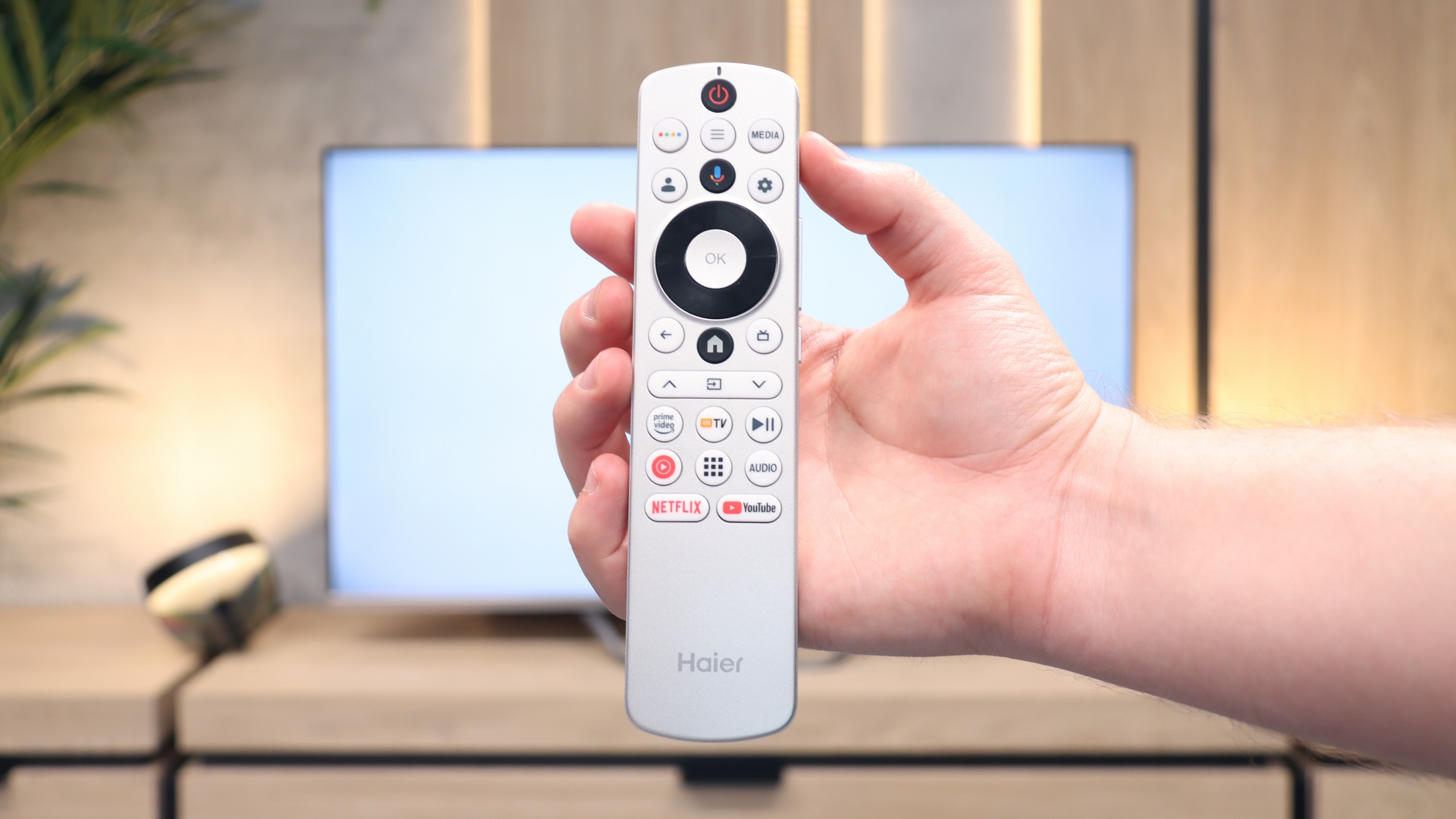

TV Features
The QN70F does not forget about classic features that still matter to many users. On board, we find, among other things, picture-in-picture mode (PiP), enabled by the presence of two tuners, teletext, and "Audio Only" mode – ideal if we want to use the TV like a radio. We can effortlessly pair it with headphones or a soundbar via Bluetooth, and the remote – despite the lack of a numeric keypad – works reliably, allowing control of other devices and additionally does not require us to aim at the screen. However, it should be noted that, as with all new Samsung models, we will not find USB recording functionality here. This is a system limitation that the brand consistently adheres to.
Smart TV QN70F – Tizen
The Tizen system, developed by Samsung for years, is one of the most refined Smart TV interfaces. It is fast, clear, and feature-rich. The QN70F supports voice search (also in Polish), wireless screen sharing from a phone (both via AirPlay and Miracast), as well as integration with watches and other devices in the Samsung ecosystem. All of this is connected by the SmartThings app, which allows controlling devices, automating tasks, and connecting devices on one network. (Not only Samsung brand). However, it is not perfect. Tizen is a closed system, so the selection of applications can be somewhat limited – especially compared to Google TV. All the major streaming services are in place, but if you use less popular services, it's worth checking before purchase whether they are available in the Samsung store.
SmartTV on Haier Q80FUX: GoogleTV
First, let's tackle the smart layer, which is managed by the Google TV system on the Q80FUX. This is theoretically a huge advantage, opening access to an endless library of applications, facilitating screen mirroring from mobile devices, and offering convenient voice search. Unfortunately, just like in other models from this brand that we've tested, the implementation of this platform leaves much to be desired. It’s not even about drastic freezes or delays in navigation, but rather a festival of minor errors, oversights, and terrible translations in the menu. It’s hard to regard "Google TV" in Haier’s version as comparable to what we know, for instance, from Sony or TCL receivers, even though the same proudly sounding name appears on the box.
Classic Features
Moving on to the classic, practical functions of the television, the picture does not improve at all. The only commendable aspect is the presence of Bluetooth connectivity and an unusual yet useful relic from the past in the form of an analog headphone output jack. Other than that, it’s hard to find anything that would excite us. Due to problematic software, the receiver (just like its predecessors in our tests) was unable to find any terrestrial TV channels, while other TVs connected to the same installation had no issues whatsoever. The remote control itself is also strange – its design might appeal to some, but due to the lack of a numeric keypad and the absurd placement of some buttons on the side edge, it definitely cannot be called senior-friendly.
Playing files from USB
9/10
9.6/10
Supported photo formats:
Maximum photo resolution:
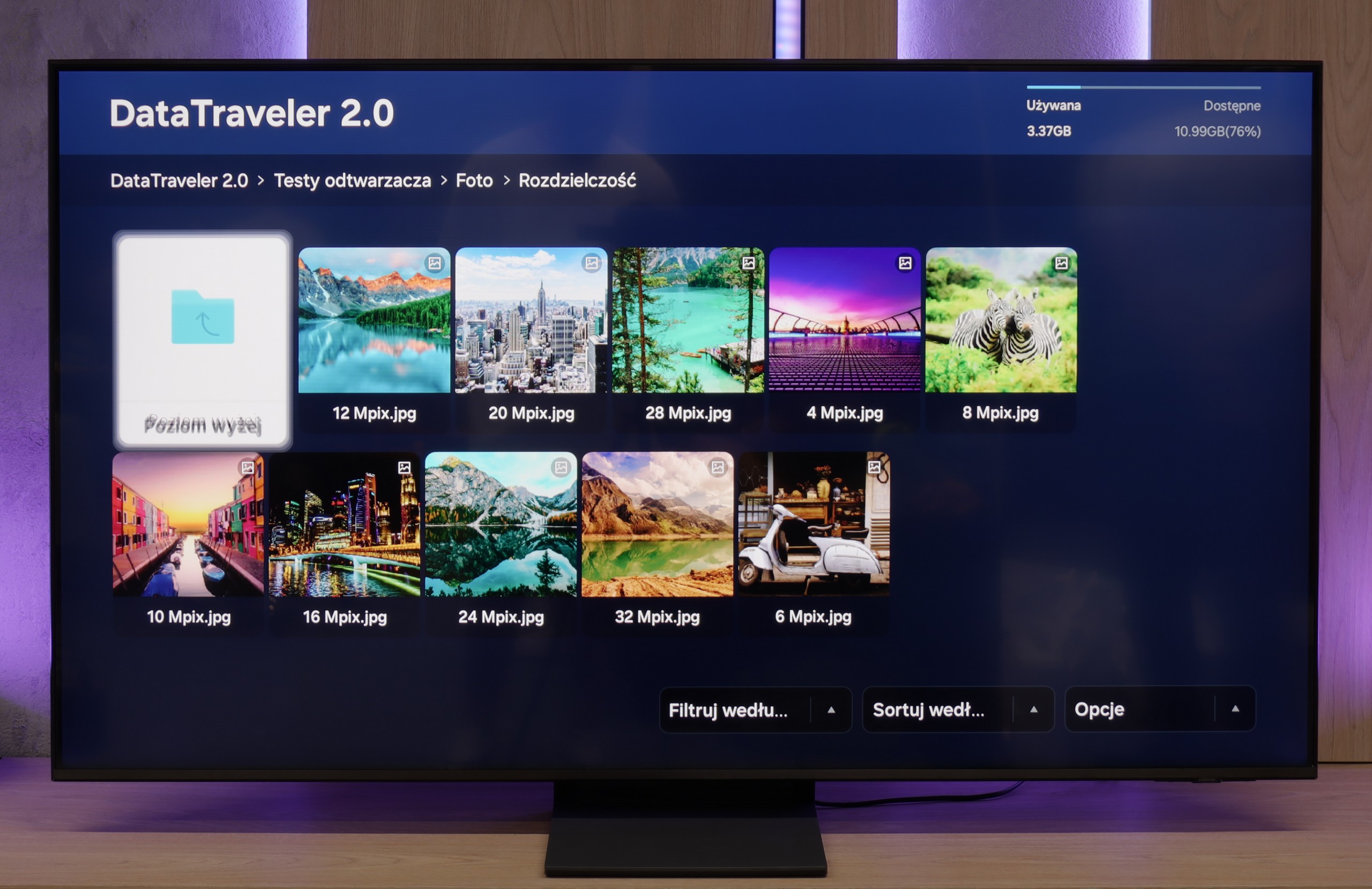
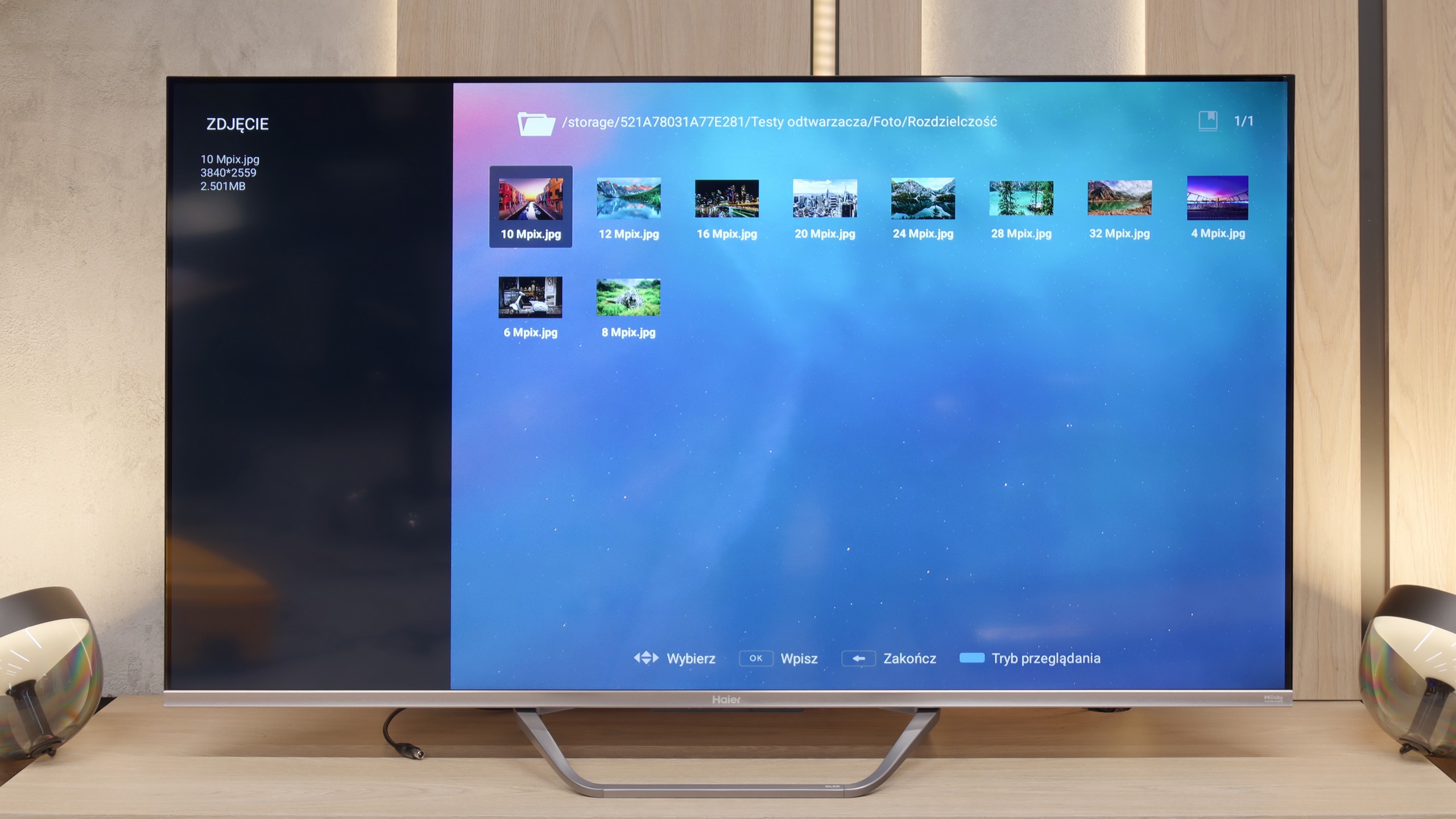
Samsung QN70F performs well in media playback – it easily runs pictures, music, and videos in the most commonly used formats. During testing, it opened JPG files, MP4, and TXT subtitles without any trouble, so for most people, this will simply be sufficient. However, there were a few files – despite having the correct extensions – that refused to play. It may be an issue with a specific version of the system, and the problem might disappear after future updates.
We must admit that after a series of setbacks we encountered when assessing the overall implementation of the Google TV system, we approached the multimedia player test with considerable caution. Meanwhile, in this one specific aspect, the Q80FUX served us a real surprise. The built-in application for handling files from USB drives works just great. This software component seems to be completely immune to the issues afflicting the rest of the system, opening virtually all the most important and popular video file formats we presented to it.
Apps
8.7/10
9.6/10














































Sound
6.4/10
5.5/10
- Maximum volume84dB84dB
- Dolby Digital Plus 7.1
- Dolby True HD 7.1
- Dolby Atmos in Dolby Digital Plus (JOC)
- Dolby Atmos in Dolby True HD
- DTS:X in DTS-HD MA
- DTS-HD Master Audio
The Samsung QN70F is quite average in terms of sound, which shouldn't be surprising given the exceptionally slim design of the television. The built-in speakers will perform adequately during daily news watching or simpler content, but it's hard to speak of any depth or spaciousness of sound here. It's simply a compromise that one has to accept when choosing an elegant and thin design over a bulkier housing with a better audio system.
Turning to the issue of acoustic "experiences," the Haier Q80FUX seems to adhere to the principle that sound should simply be. And it is – that’s about all that can be said about it. The built-in speakers produce sound that is exceedingly flat, lacking character, and most importantly, they lack any clear bass foundation. One comfort is the fact that the TV supports Dolby Atmos format. But let’s be honest: to truly take advantage of the benefits of this codec and hear the promised space, passive decoding capability is not enough. Connecting an external home theater system or at least a decent soundbar is, in this case, not just a recommendation but an absolute necessity.
Sound Quality Test
No sound test video
Acoustic Measurements
84dBC (Max)
75dBC
84dBC (Max)
75dBC
